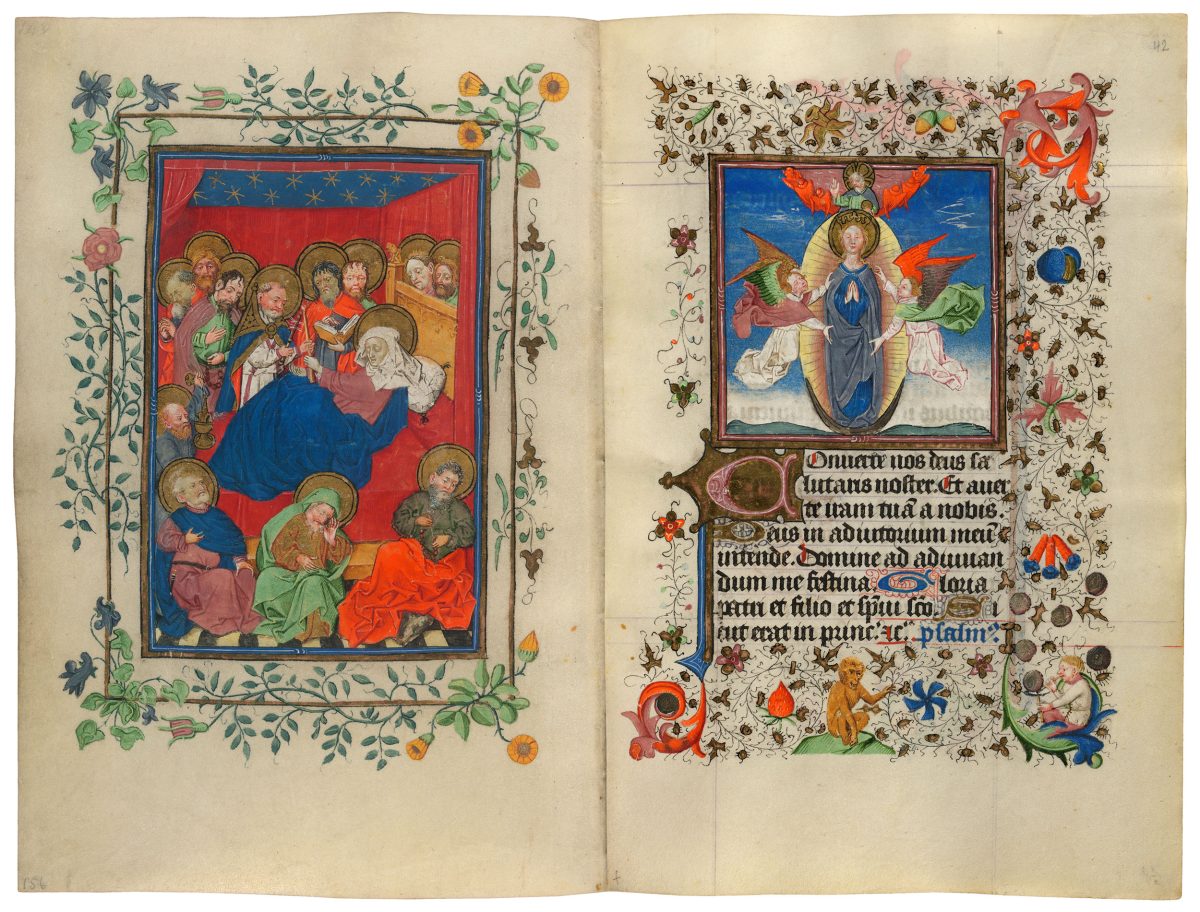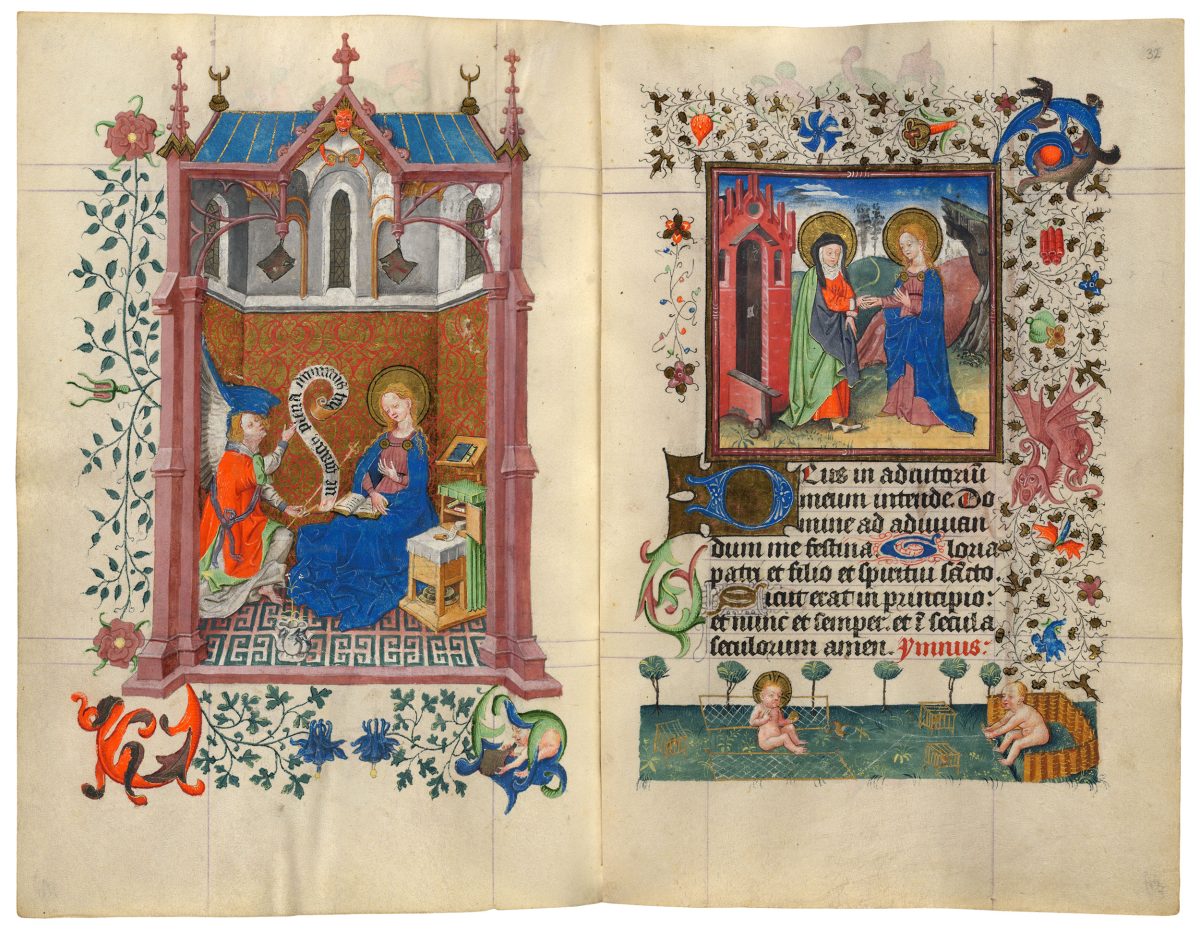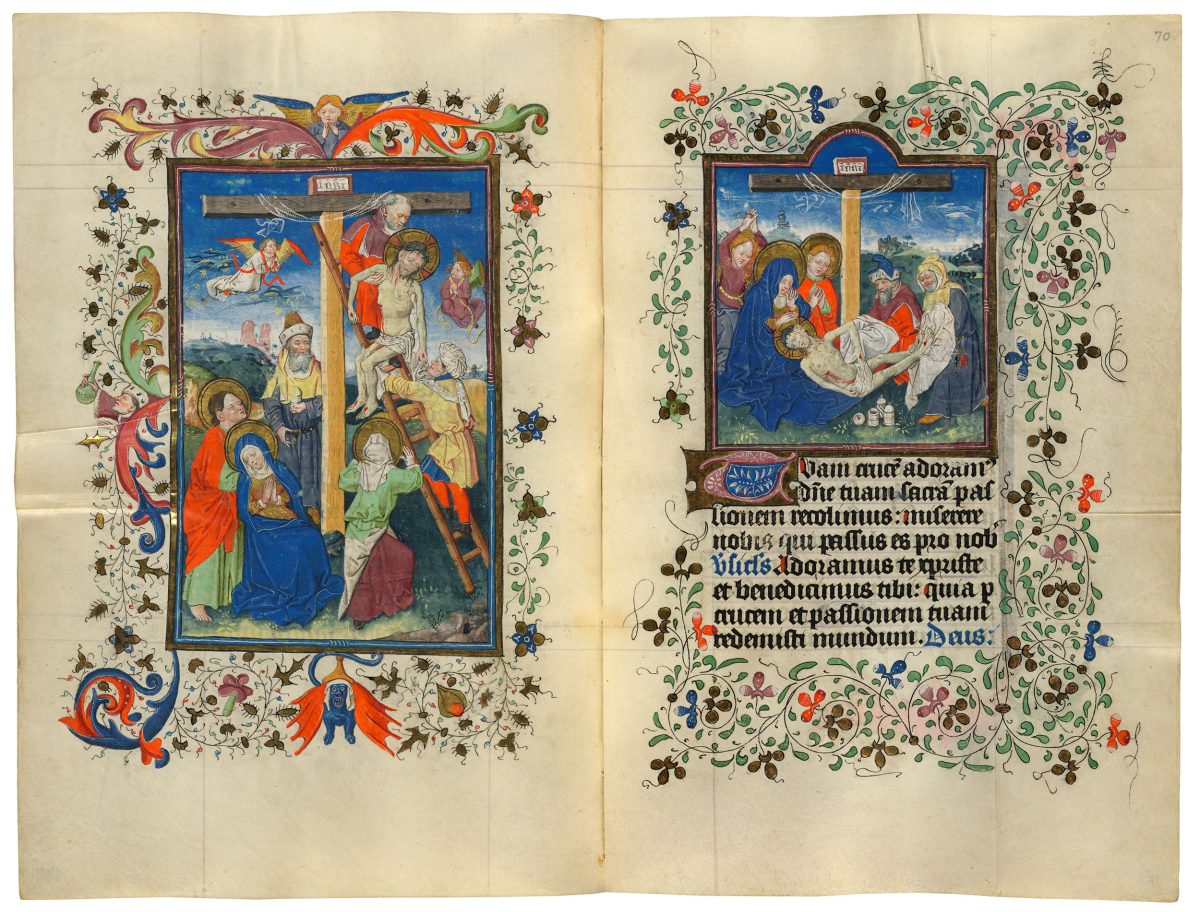In The Hours of Catherine of Cleves (c.1440), we get to Jesus in a way that challenges how we perceived the Christ child. Early images of Jesus portrayed him as a boyish, fun type, beardless with curly locks, and nothing like the long-haired Jesus of the Turin Shroud, say, or the Jesus we see wracked in pain on the outside Victorian-era churches. That Jesus is a Medieval Jesus.
So when in the Renaissance Catherine of Cleves painted Jesus as a dewey-faced boy in a walker, scampering about the kitchen as mother Mary made dinner and father Joseph whittled what could be a cricket bat, she was harking back to early versions of the boyish Jesus that had endured for 1,000 years.
There’s more than just that image of domesticity in the Hours of Catherine Cleves, an ornately illuminated manuscript in the Gothic art style, produced in about 1440 by the anonymous Dutch artist known as the Master of Catherine of Cleves. The lush book of hours contains the customary offices, prayers and litanies in Latin, supplemental texts, and, of interest to us, 157 colourful and gilded illuminations.
The work is divided into sections: Hours of the Virgin; Hours of the Passion; Hours and Masses for the Seven Days of the Week; Penitential Psalms and Litany; Office of the Dead; and Suffrages.
Hours of The Virgin
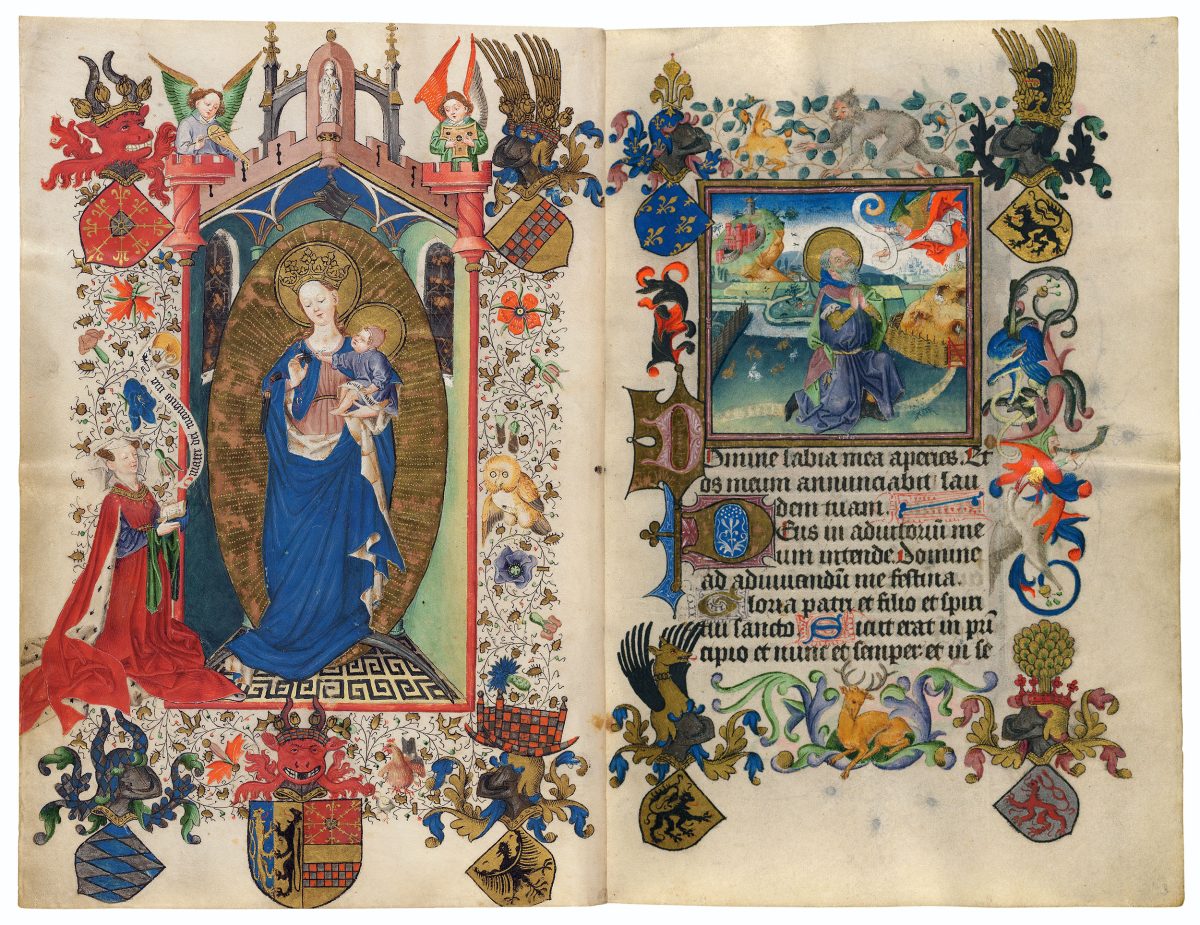
Every Book of Hours features Hours of the Virgin. Each Hour is contains psalms, hymns, biblical readings, and short phrases (antiphons, versicles, and responses). The eight Hours are to be prayed throughout the day:
Matins and Lauds at night or upon rising
Prime (first Hour) at 6:00 a.m.
Terce (third Hour) at 9:00 a.m.
Sext (sixth Hour) at noon
Nones (ninth Hour) at 3:00 p.m.
Vespers (evensong) in the early evening
Compline before retiring.
The Hours of the Virgin first appeared in the ninth century. By the late twelfth century, the Hours was a mainstay of Psalters, prayer books popular with laypeople. As people grow wealthier and better educated, by the mid thirteenth century the Hours of the Virgin formed the central plank of the laypeople’s prayer book, the Book of Hours.
Catherine’s prayer book begins with an image of Catherine herself. She’s praying from her Book of Hours before the Virgin Mary and Child. On the right, the story of Mary’s life of the life begins with an angel telling the Virgin’s father, Joachim, that his wife is pregnant. The rabbits symbolize this newfound fecundity. The borders hail Catherine’s noble lineage: eight of her ancestors’ arms fill the corners of the folios. Her own arms as duchess of Guelders are positioned directly below the Virgin. In a heraldic act of defiance and female emancipation, she surmounts her arms not with her husband’s crest but with the ox of her own house of Cleves.
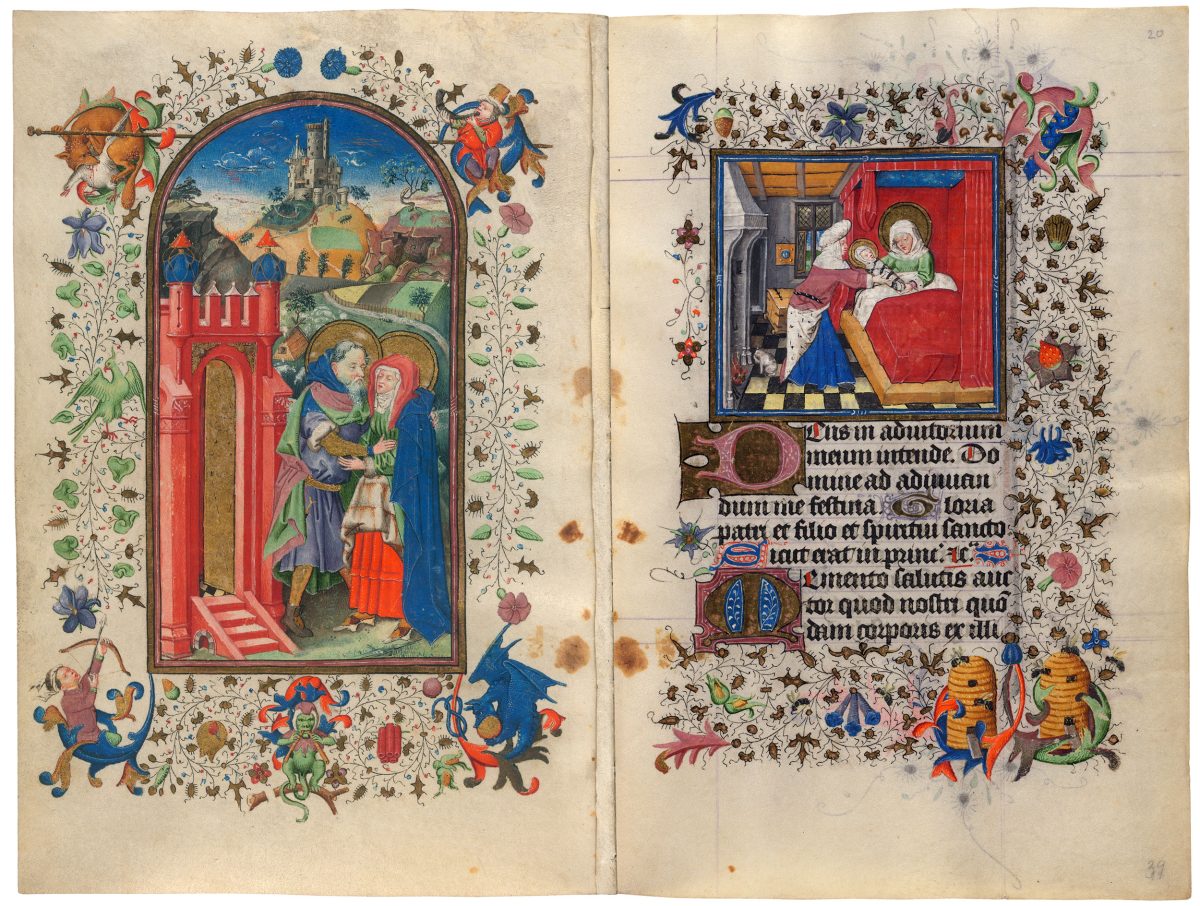
Joachim and Anne Meeting at the Golden Gate Birth of the Virgin
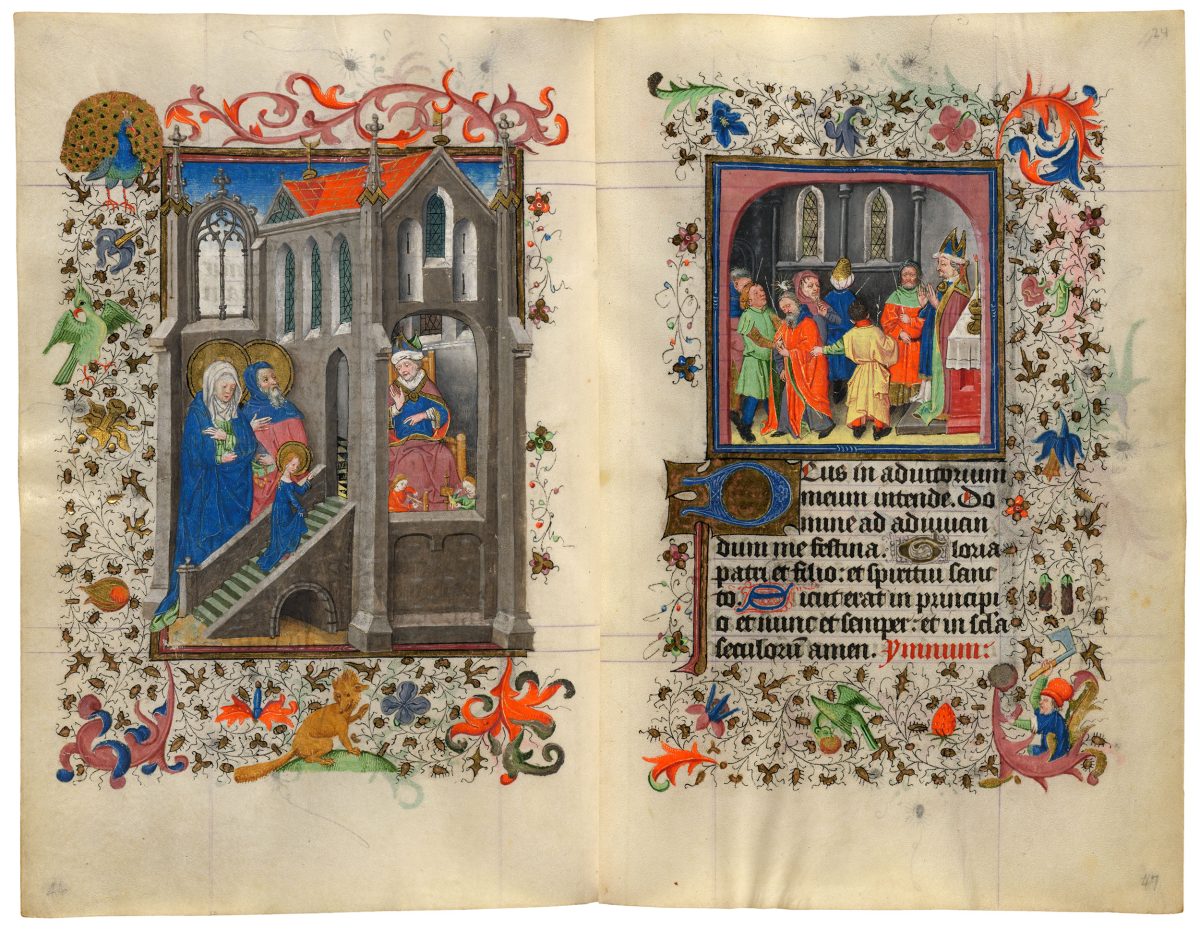
Presentation of the Virgin in the Temple Joseph Designated as the Husband of the Virgin
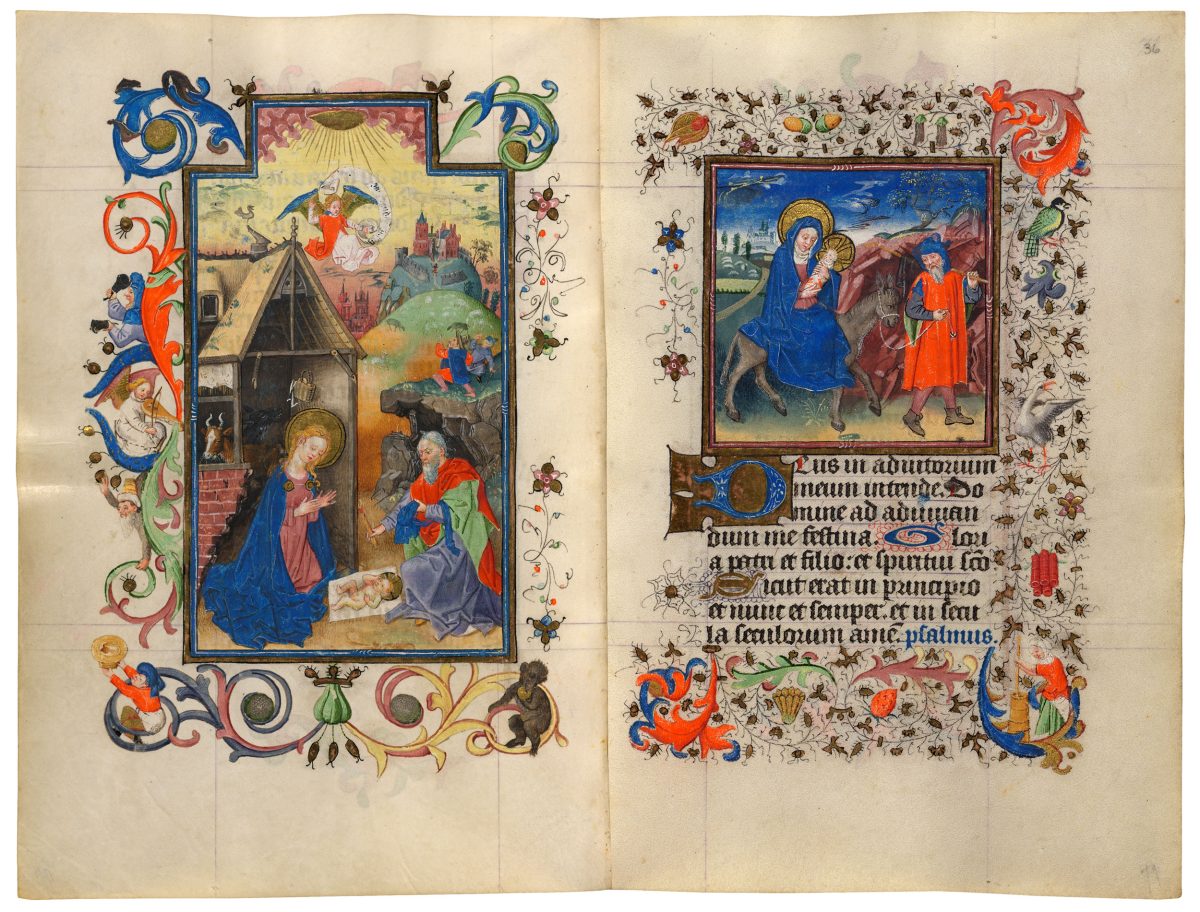
Nativity Flight into Egypt

Marriage of the Virgin God Dispatching the Archangel Gabriel
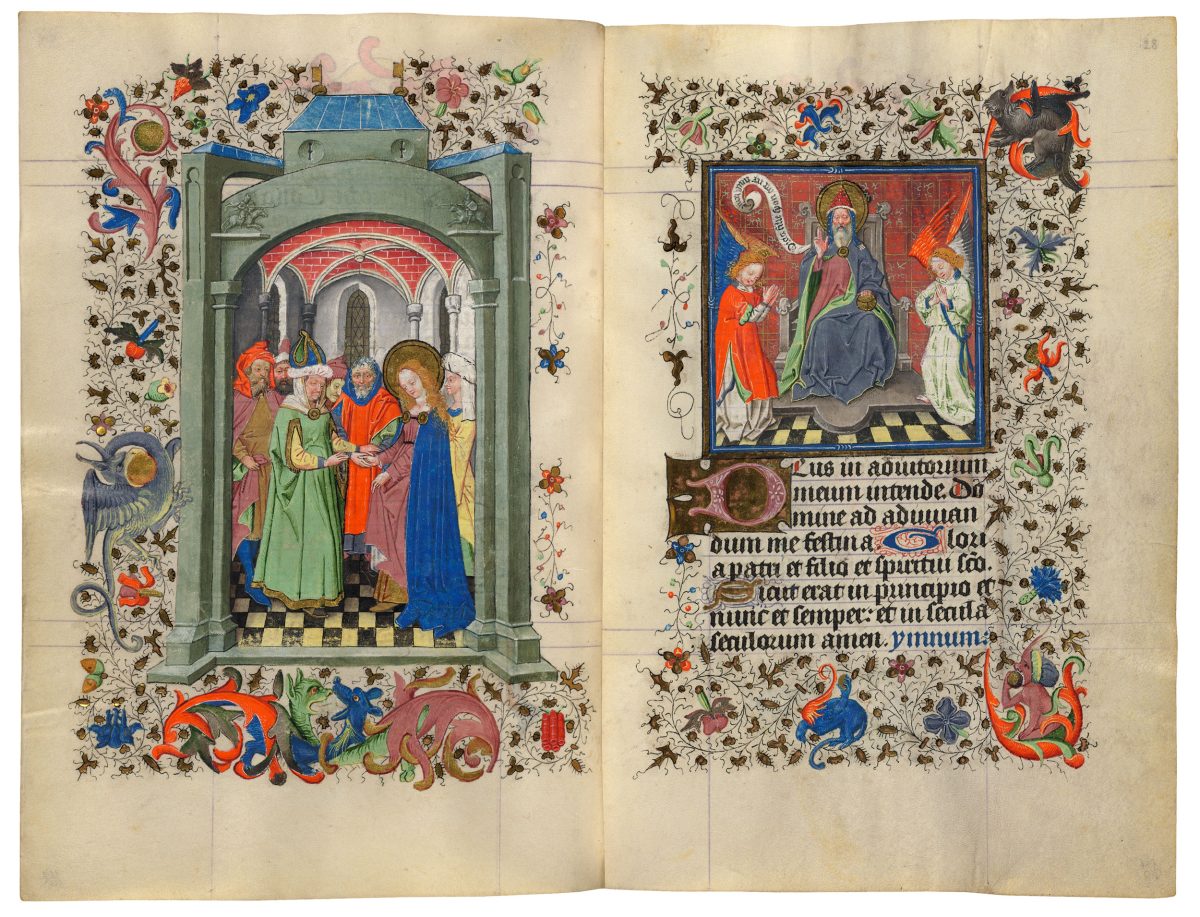
Marriage of the Virgin God Dispatching the Archangel Gabriel
Hours of The Passion
The Hours of the Passion is illustrated by full and half-page miniatures. The story begins with Christ in the garden of Gethsemane. The Hours of the Passion also features lengthy psalms supplemented with prayers that narrate the story of Christ’s Passion.
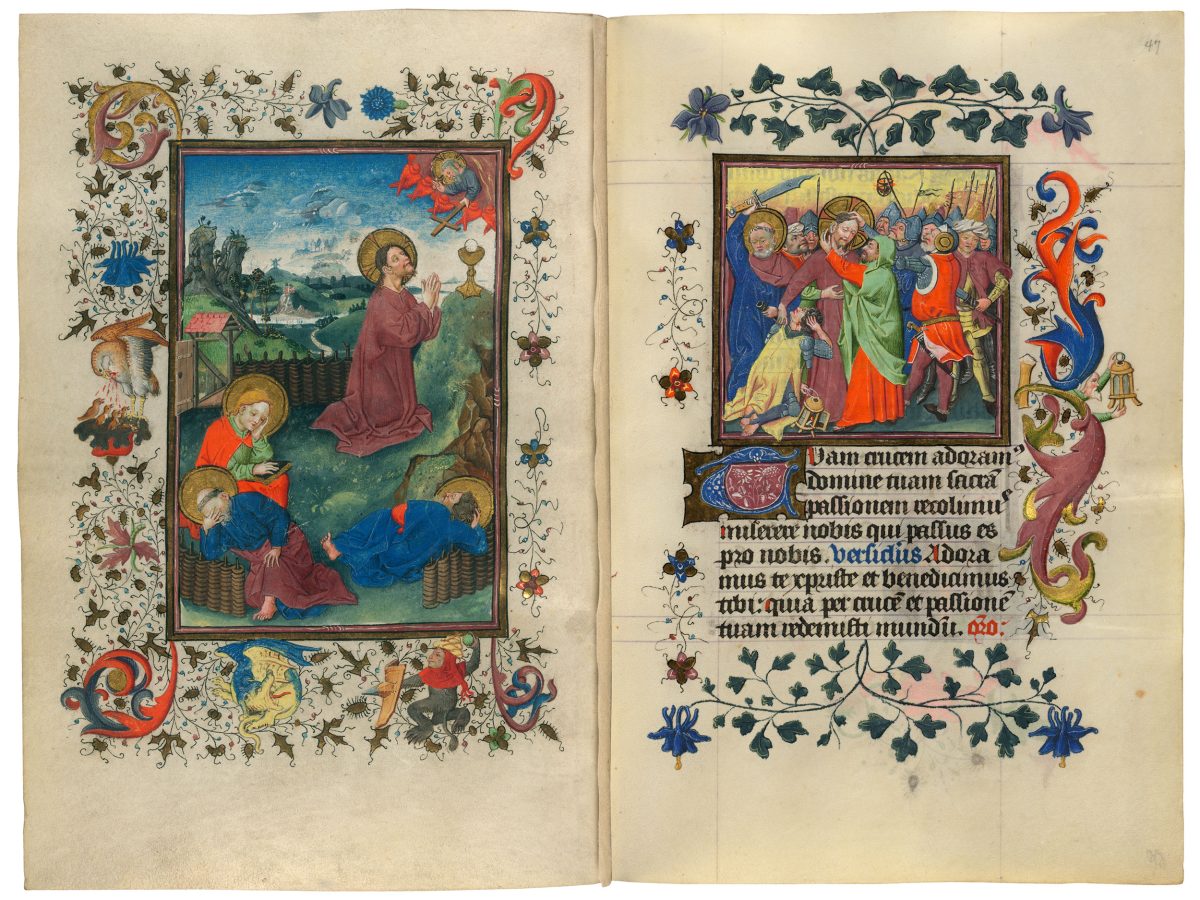
Agony in the Garden, Arrest of Christ

Christ before Caiaphas Christ Mocked
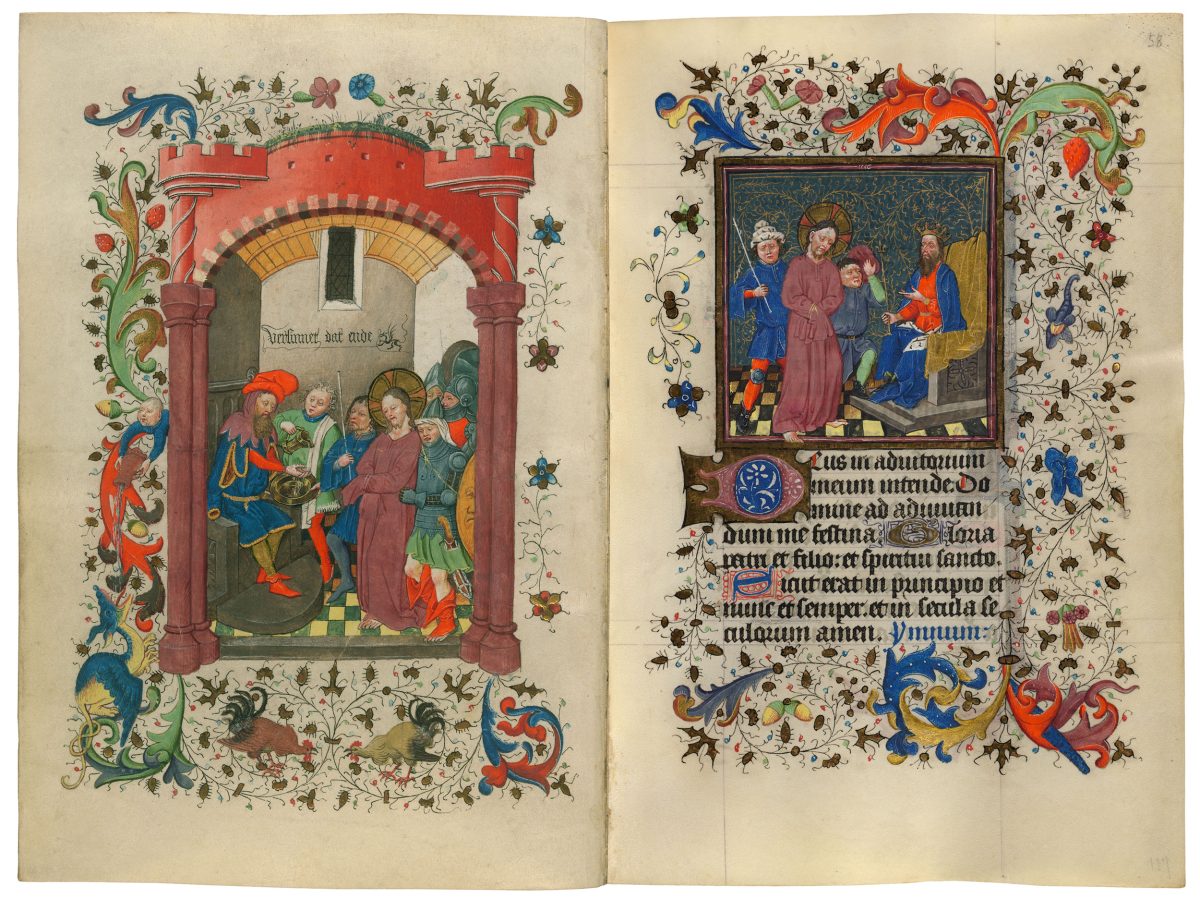
Christ before Pilate Christ before Herod

Christ before Pilate Christ before Herod
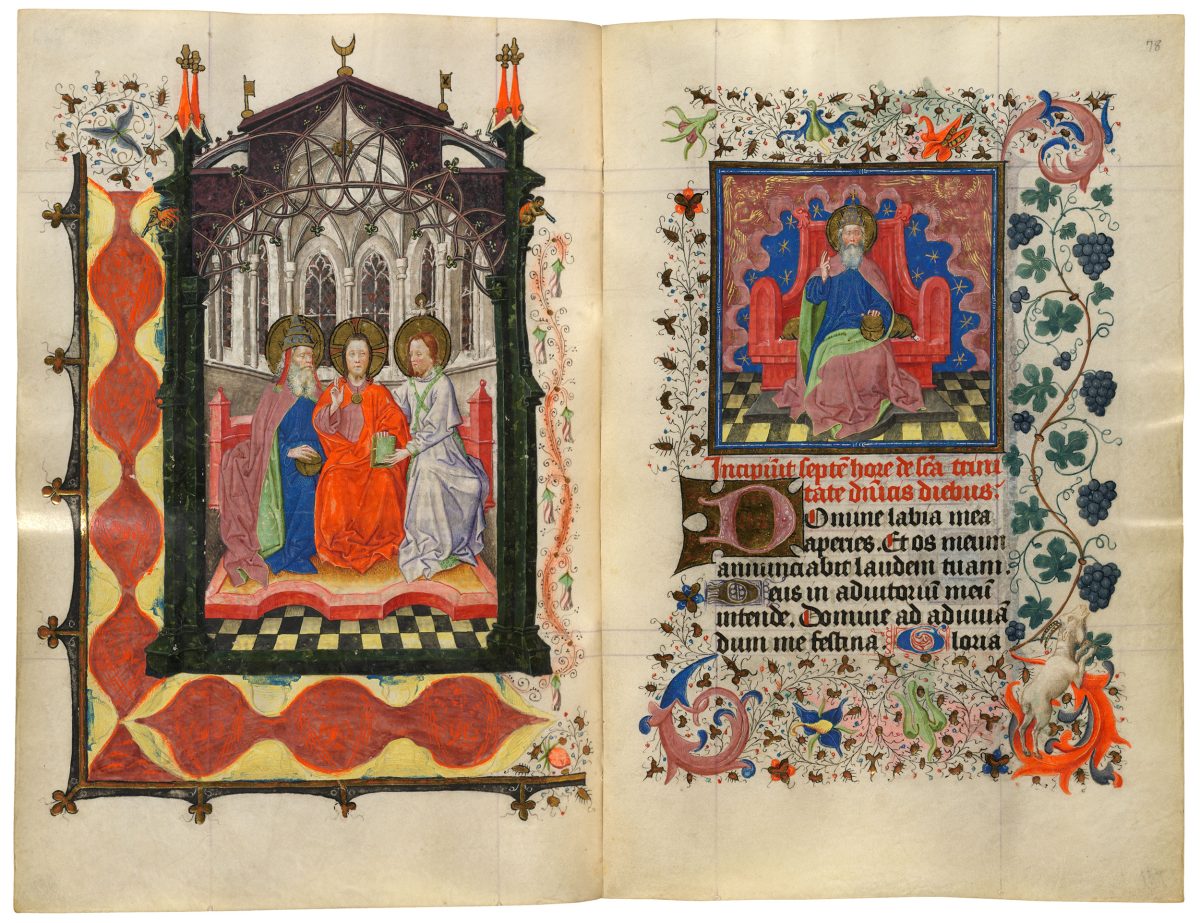
Trinity in an Apse God the Father

Entombment Resurrection

Crucifixion Joseph of Arimathaea before Pilate
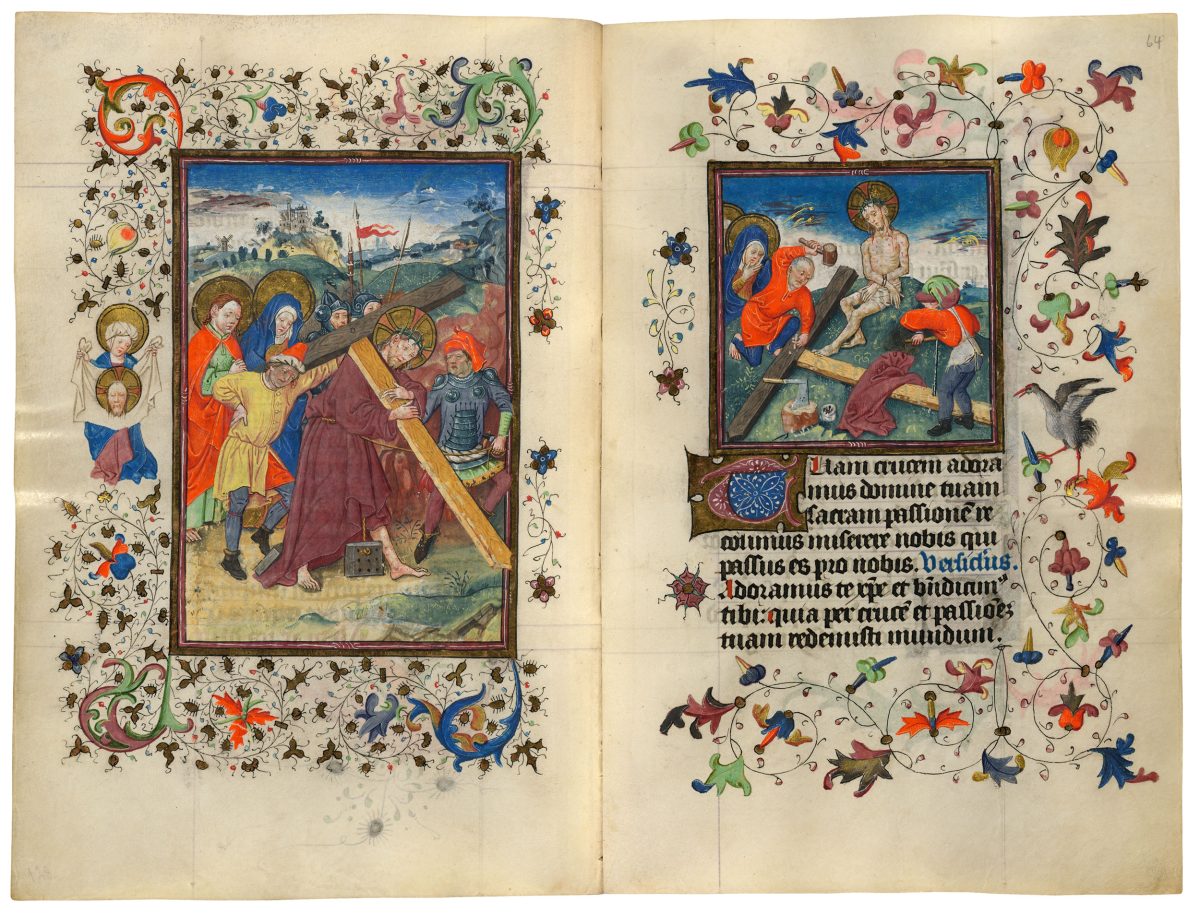
Christ Carrying the Cross Preparation of the Cross
Hours and Masses for the Seven Days of the Week
Hours and Masses for the Seven Days of the Week
The most unusual texts in Catherine’s manuscript are the series of Hours and Masses for every day of the week. Medieval Christian tradition associated certain figures or themes with different days. Thus Sunday, the day of the Resurrection, was the Lord’s Day; Thursday was connected with the Eucharist since that sacrament was instituted on Holy Thursday; and Monday was the day of the dead, since their torments were suspended on Sunday but recommenced the following day. In Catherine’s prayer book, the themes for the Hours and Masses of the seven days of the week are:
Sunday the Trinity
Monday the Dead
Tuesday the Holy Spirit
Wednesday All Saints
Thursday the Blessed Sacrament
Friday the Compassion of God
Saturday the Virgin.

God the Son
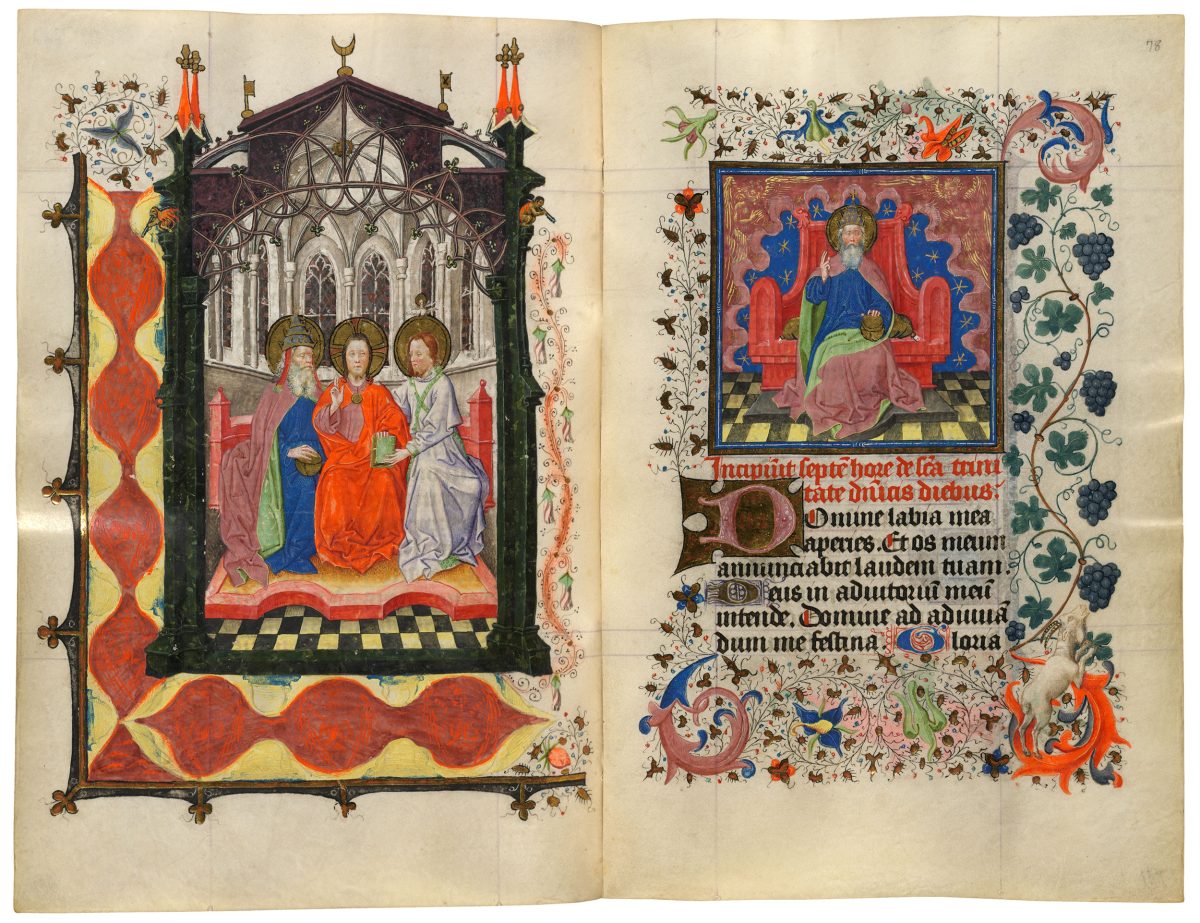
Trinity in an Apse God the Father
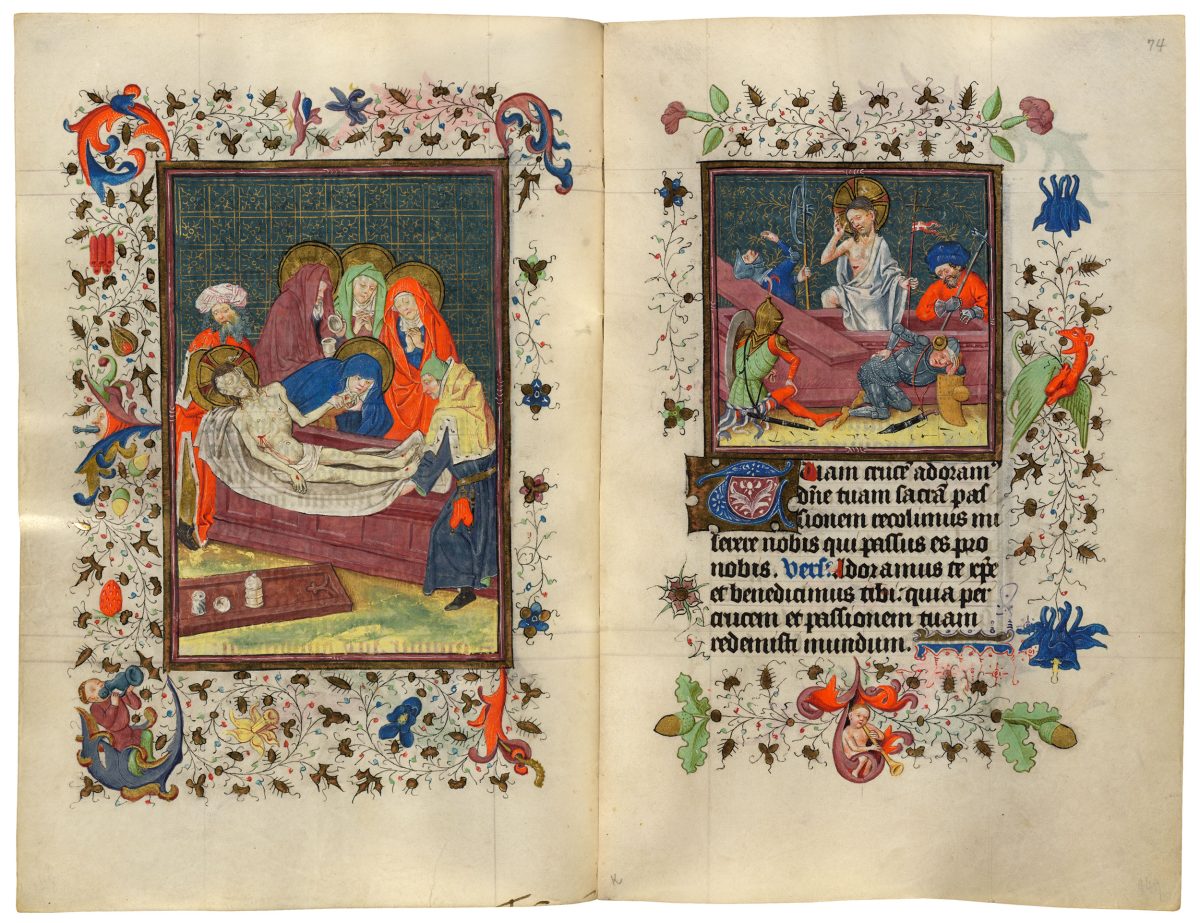
Entombment Resurrection
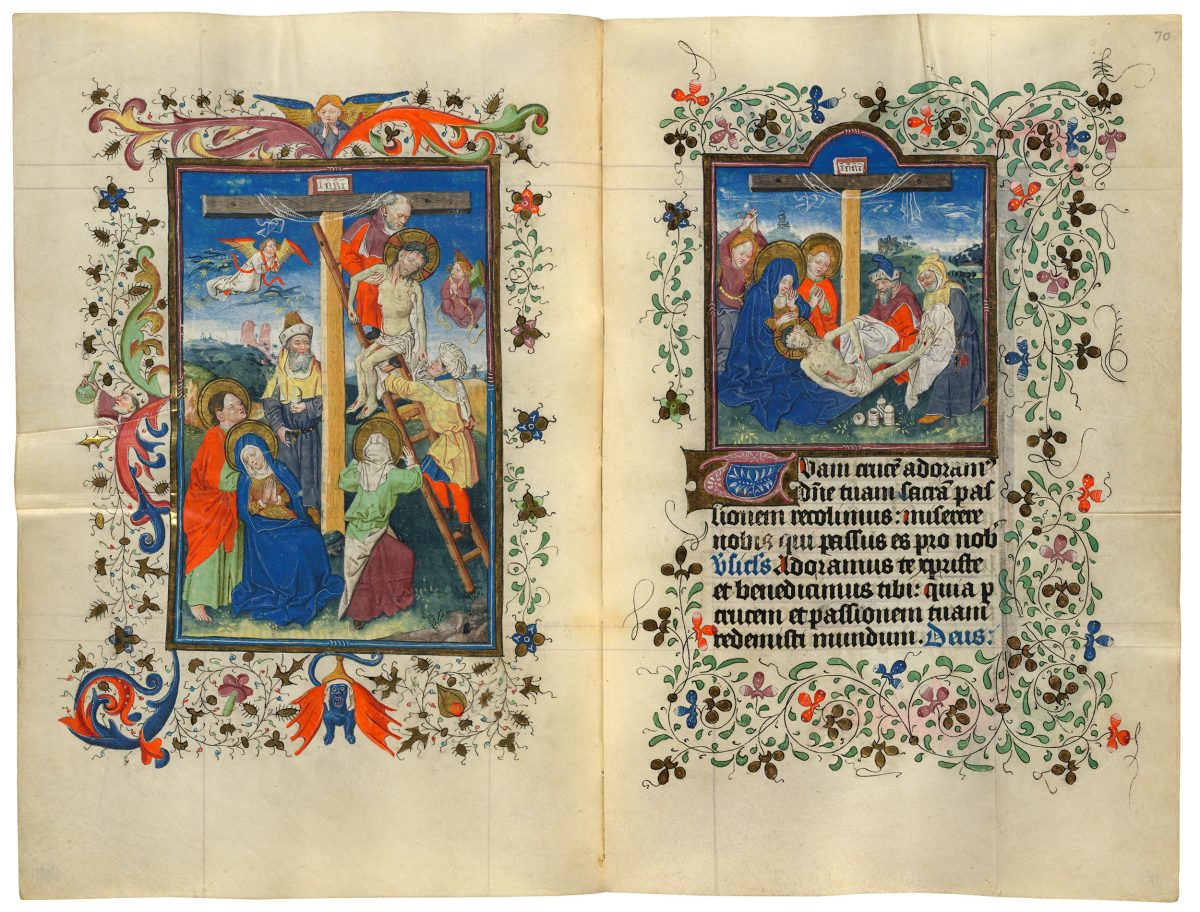
Deposition Lamentation
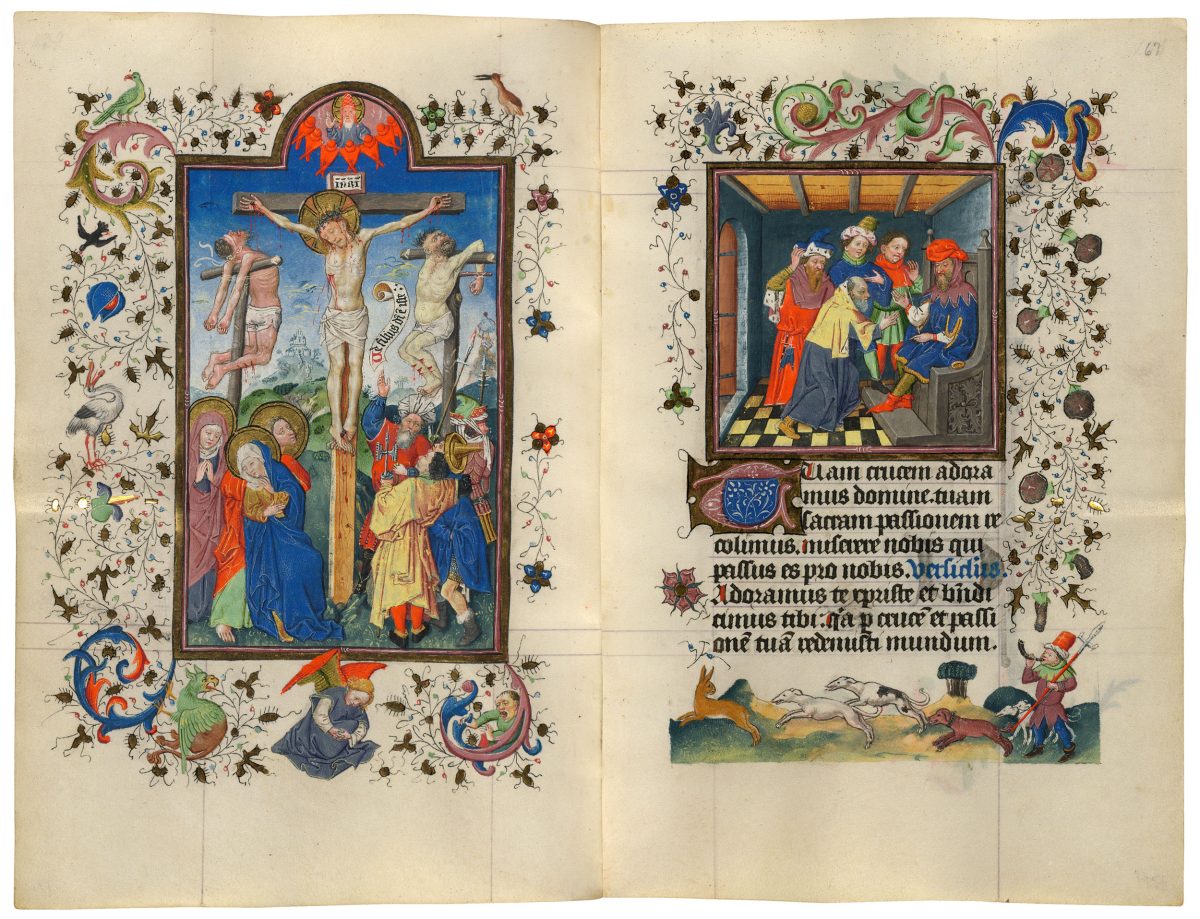
Crucifixion Joseph of Arimathaea before Pilate
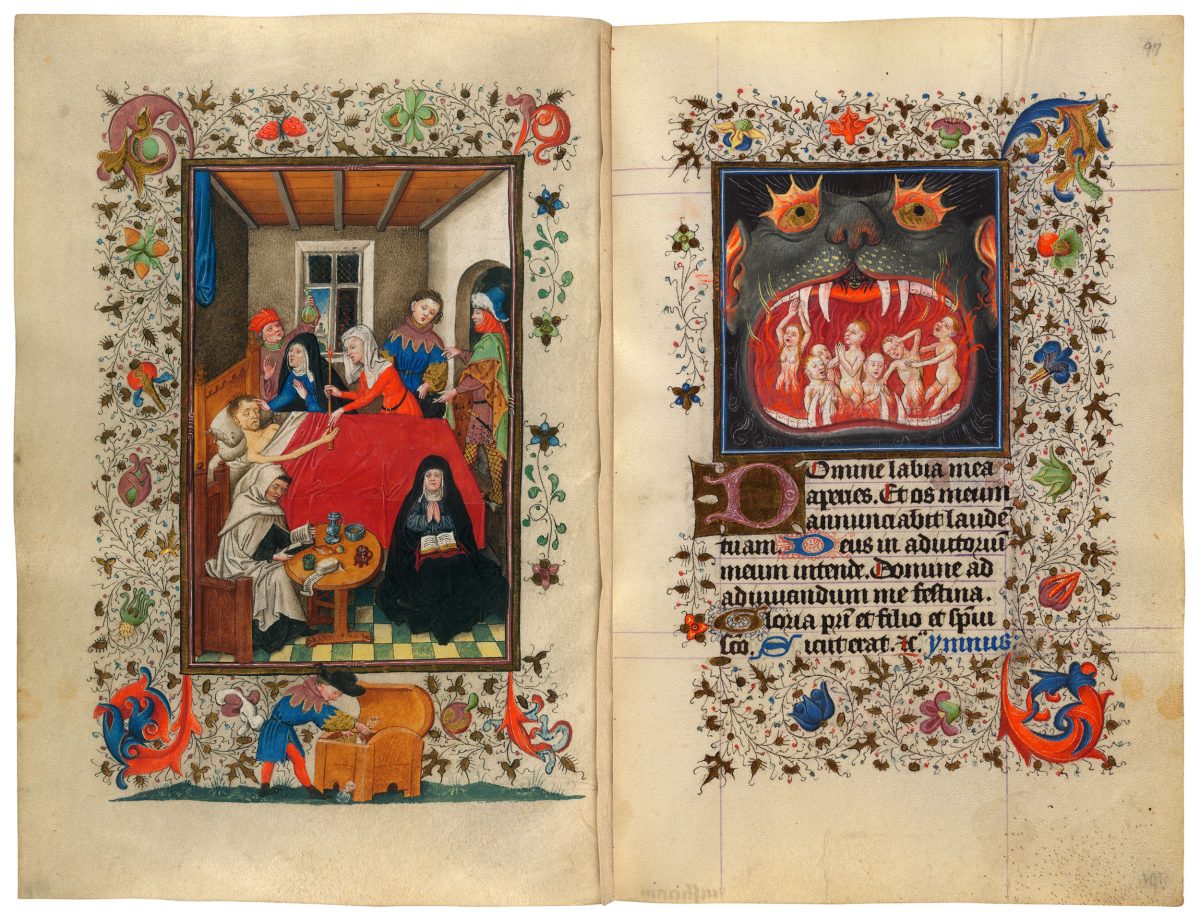
Deathbed Souls Tormented in Purgatory

Infant Christ Sent to Earth

Preparation of the Corpse
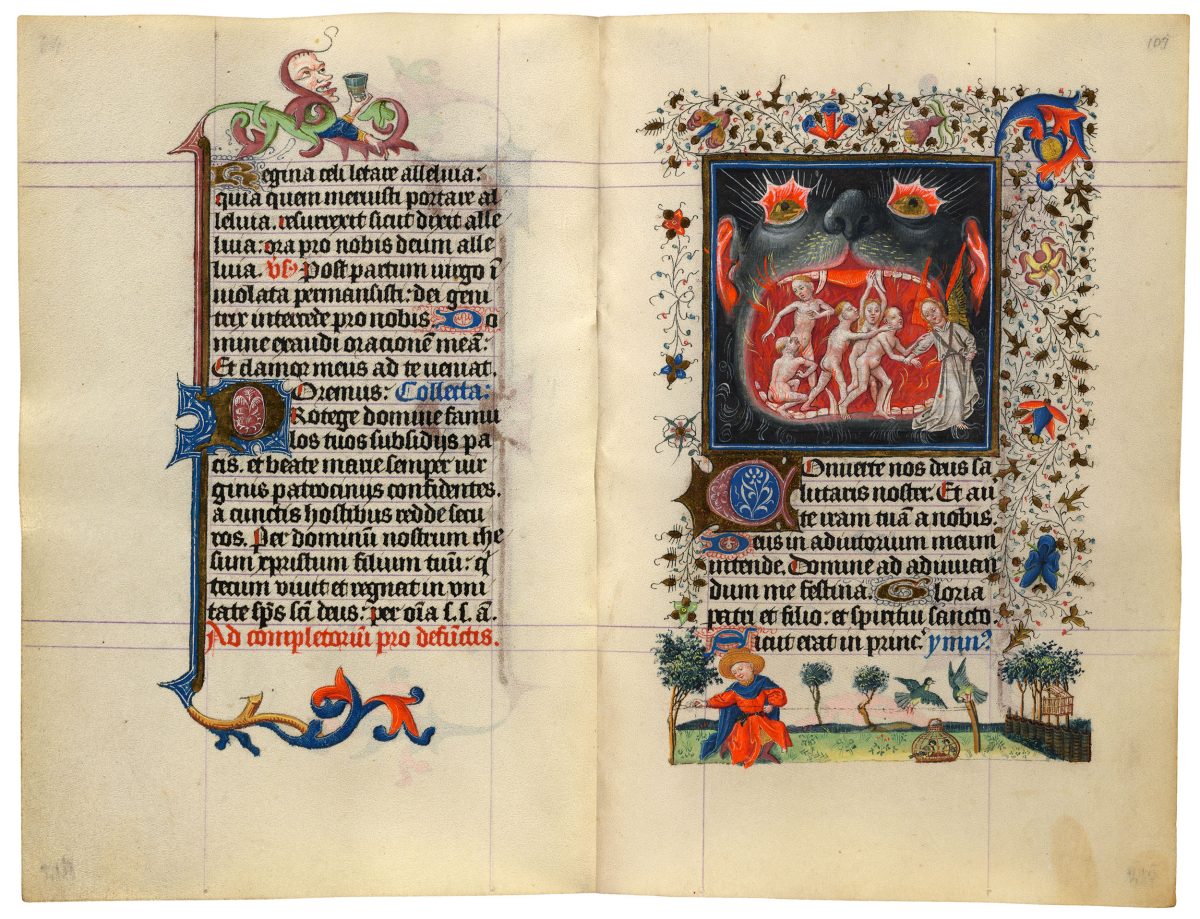
Souls Released from Purgatory
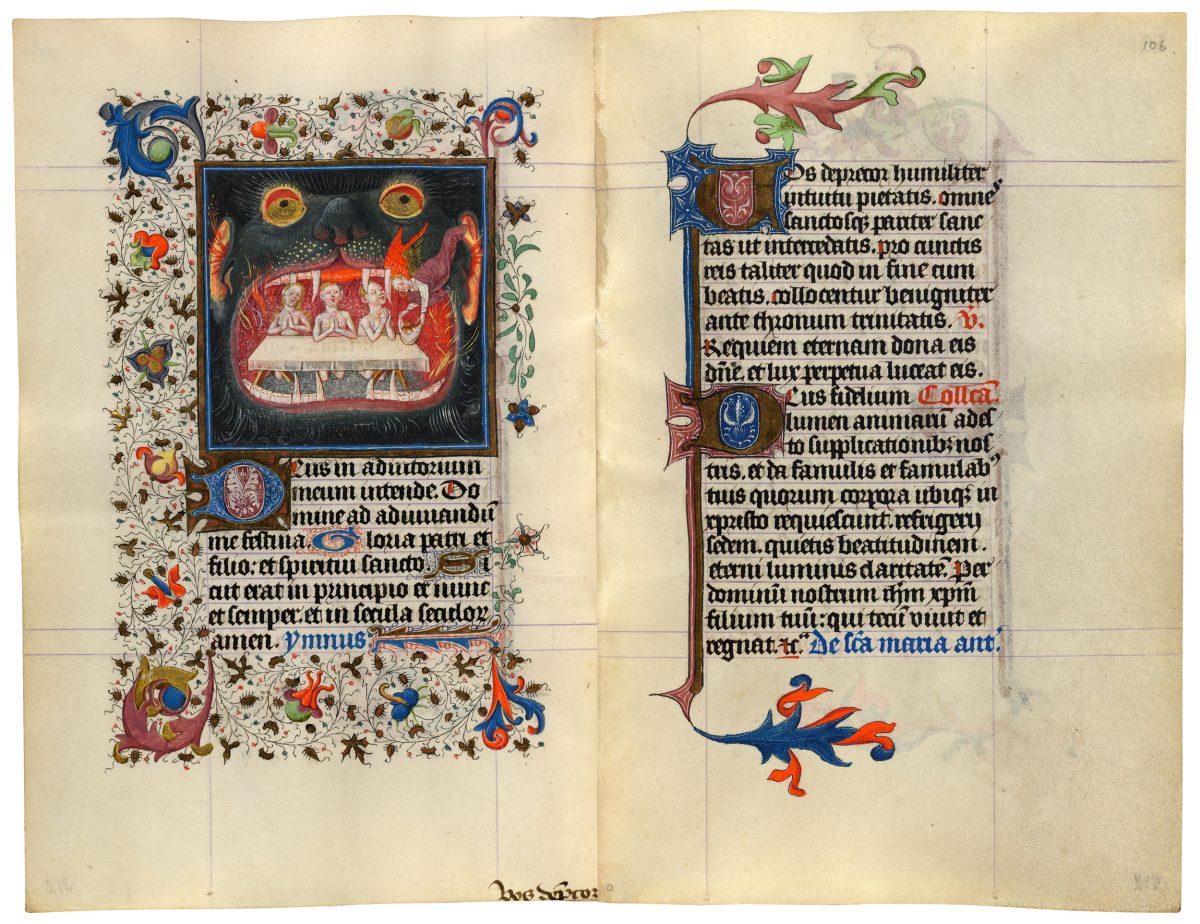
Souls in Purgatory Consoled with the Offering
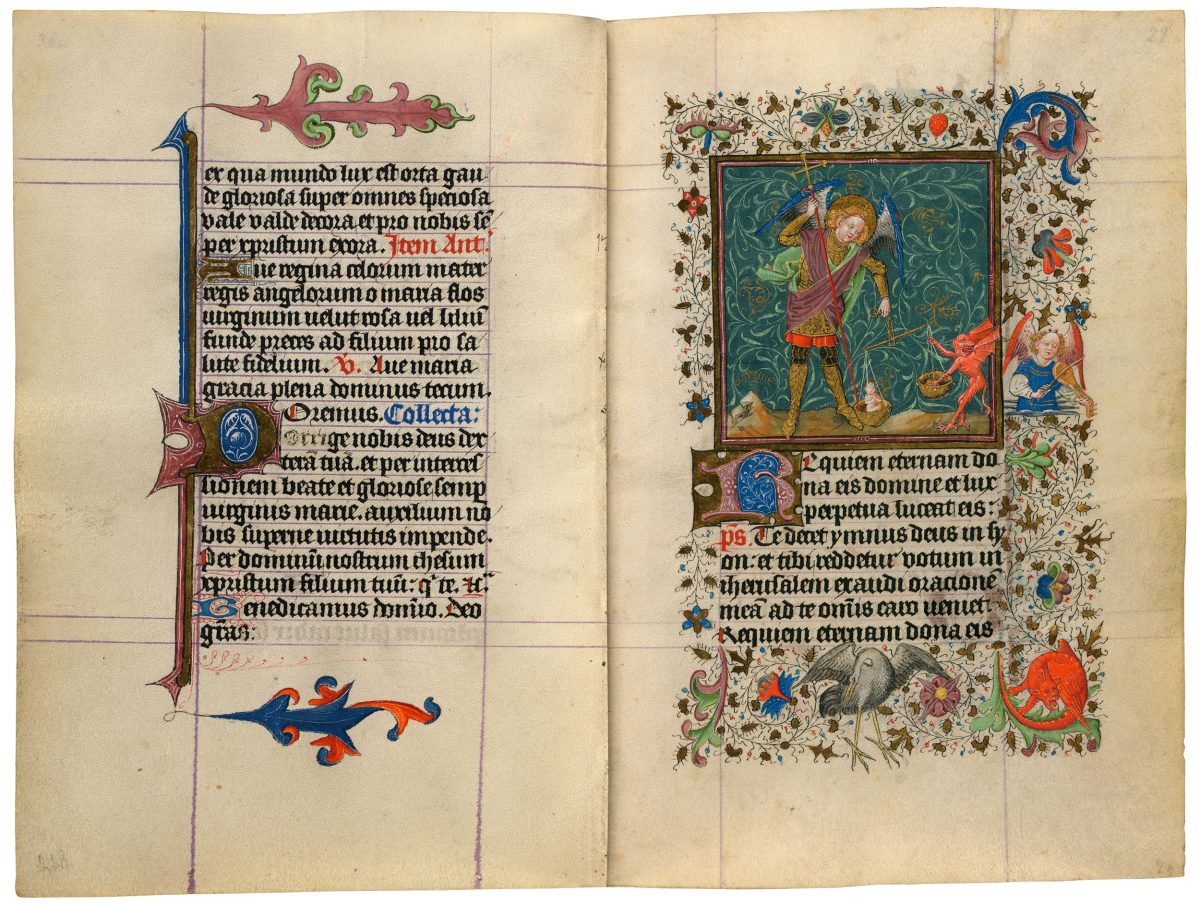
St. Michael Weighing Souls
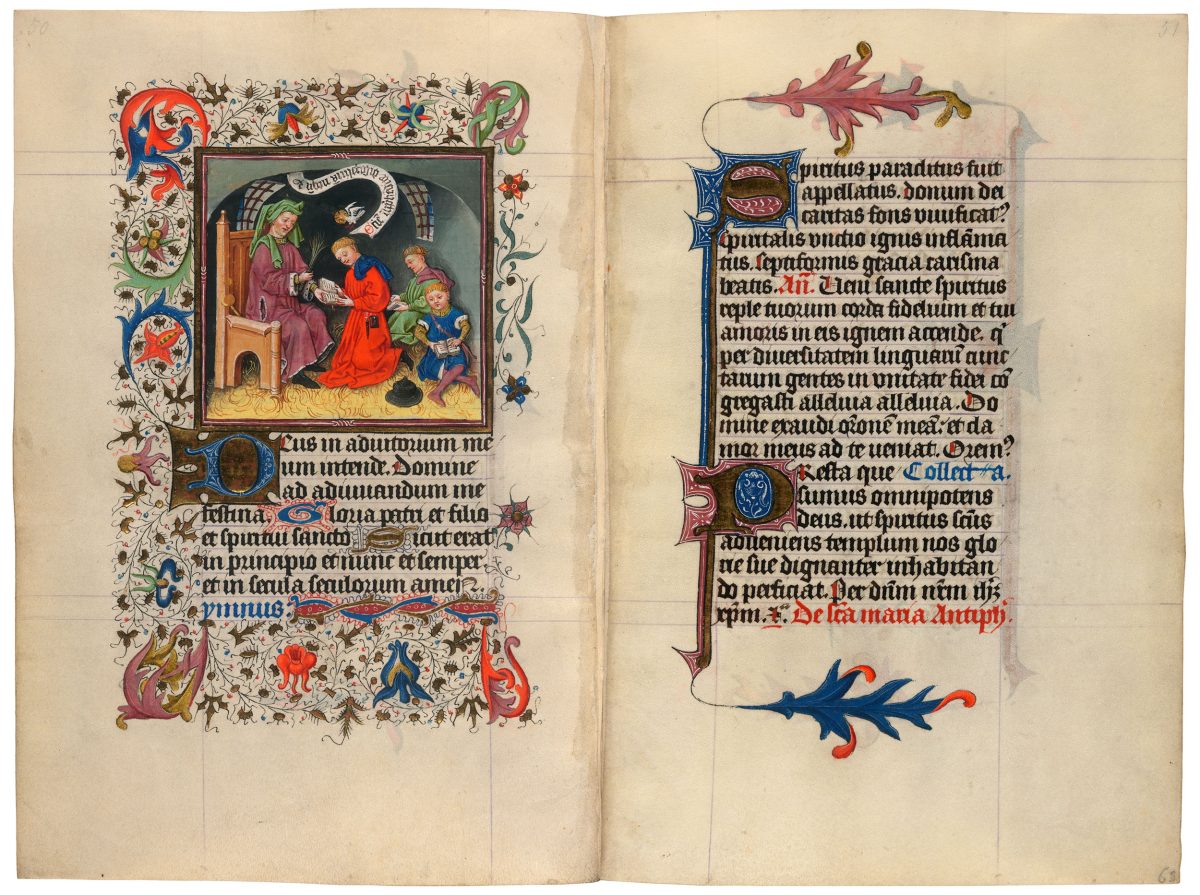
Teacher Instructing Pupils

Jacob Struggling with the Angel
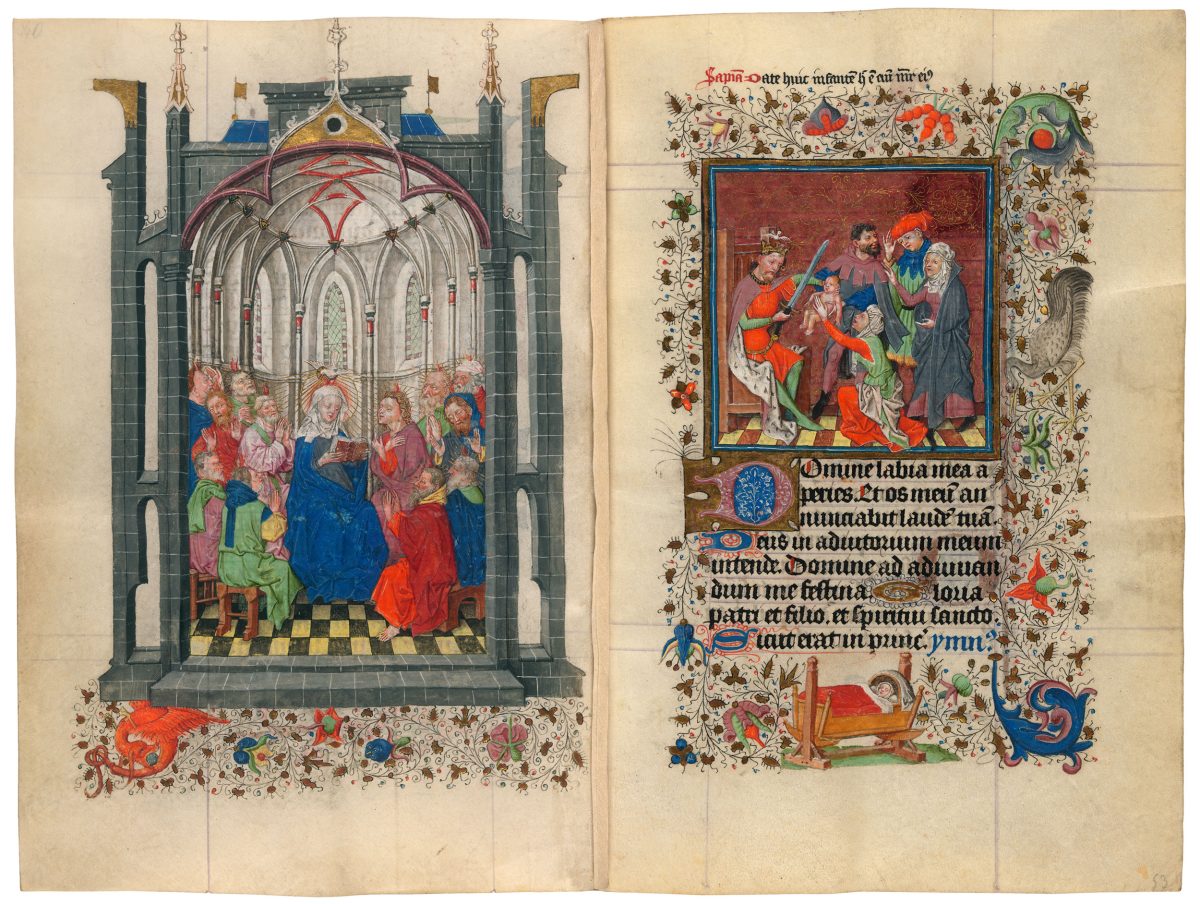
Pentecost Judgment of Solomon
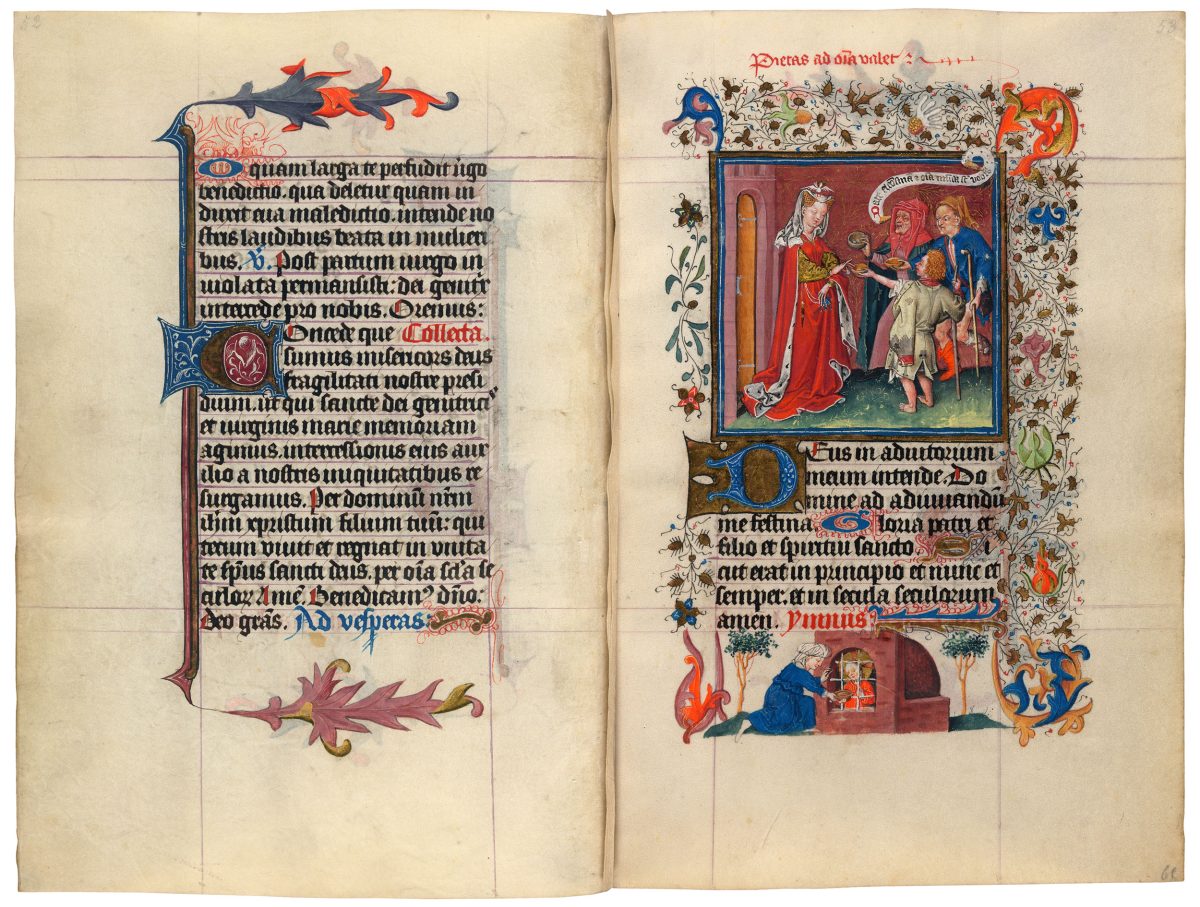
Catherine of Cleves Distributing Alms
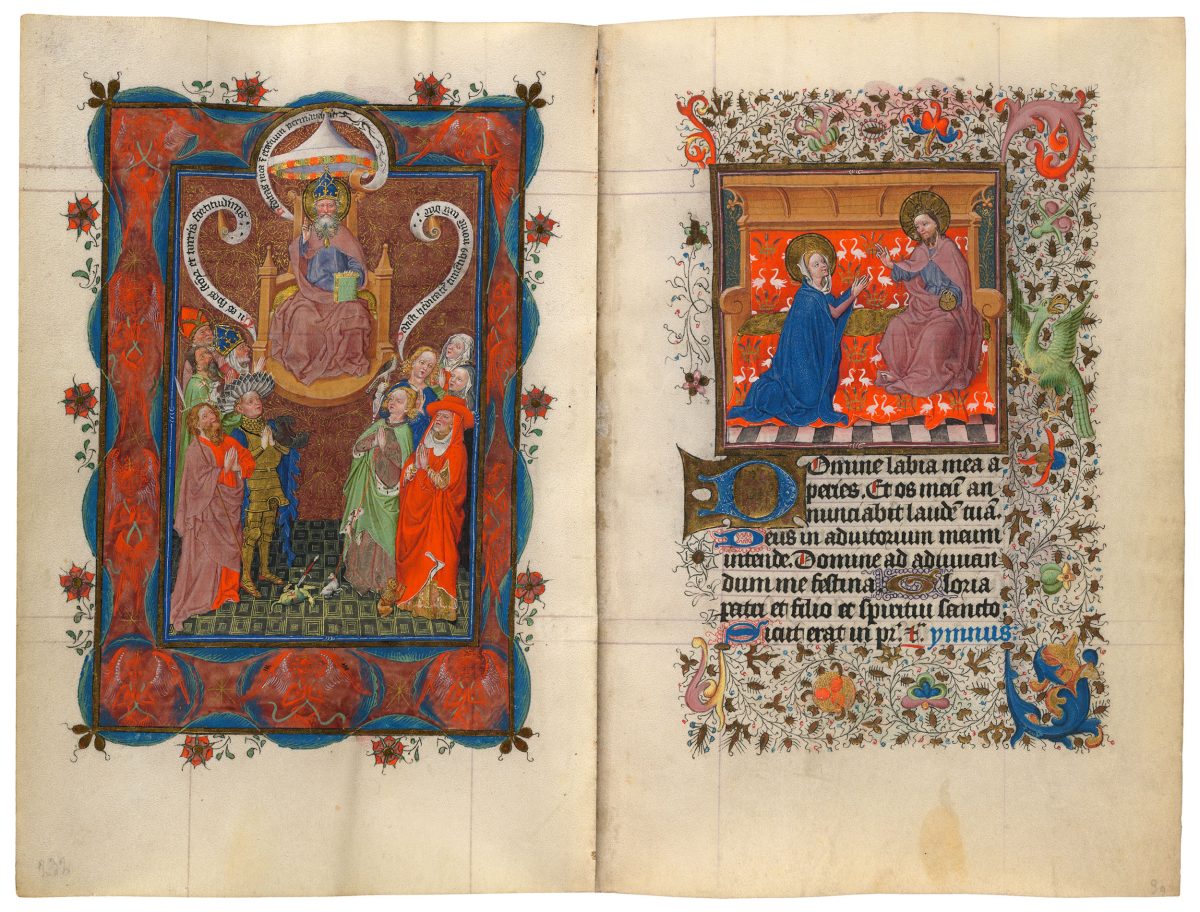
All Saints before the Throne of God Christ Receiving the Virgin into Heaven
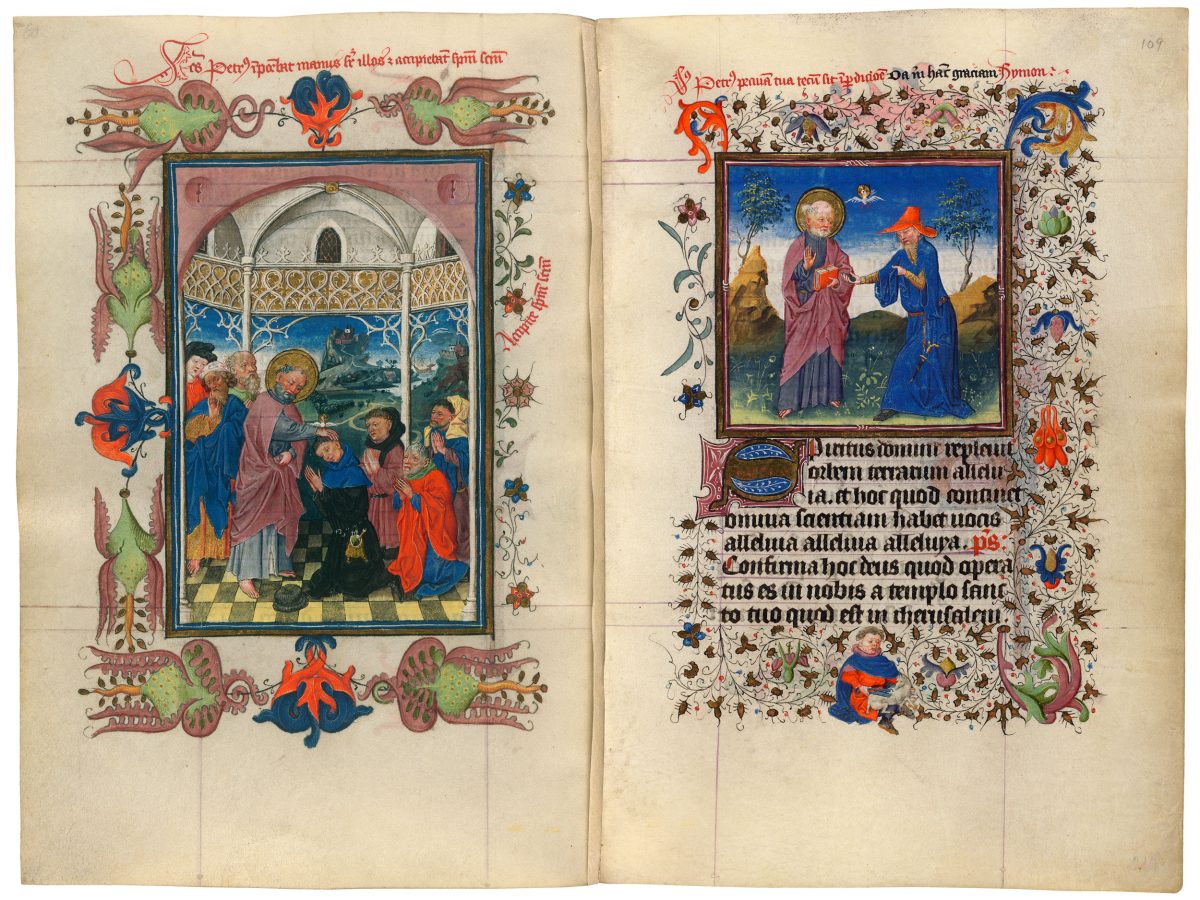
St. Peter Bestowing the Holy Spirit Simon Magus Seeks to Buy Peter’s Power
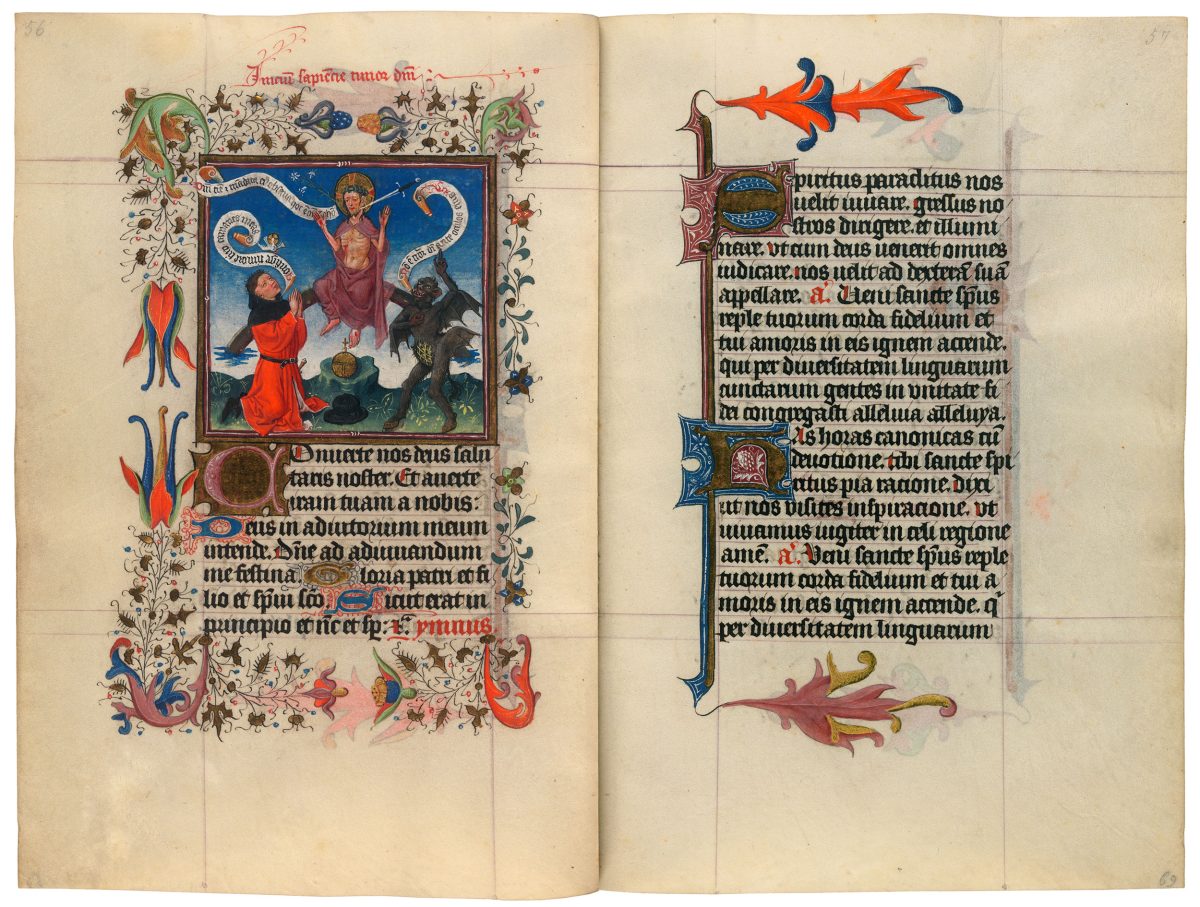
Arnold of Egmond, Catherine of Cleves’ Husband, Praying to Christ

God Surrounded by the Symbols of the Evangelists

SS. Peter, John the Baptist, and Martin
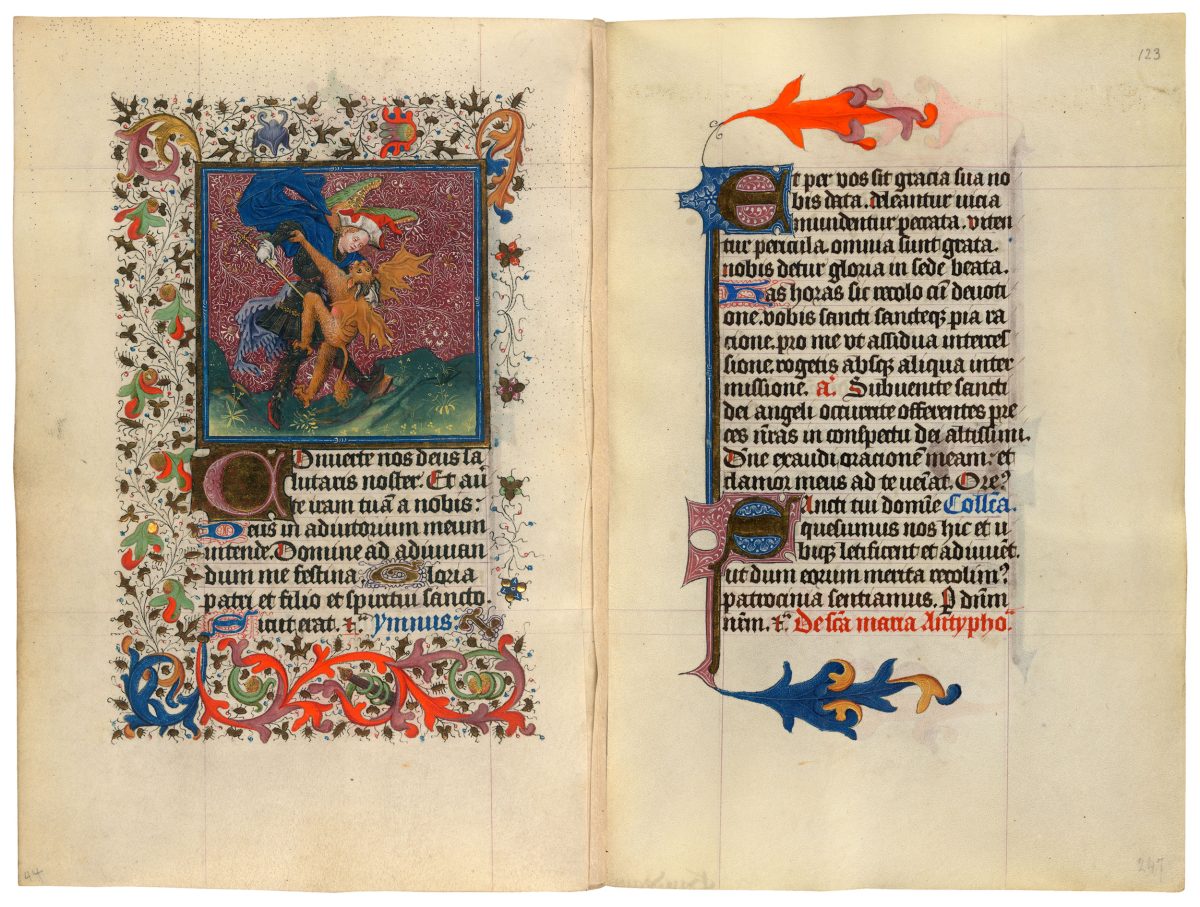
St. Michael Battling a Demon

Last Supper The Celebration of Mass Observed by Moses and St. Paul
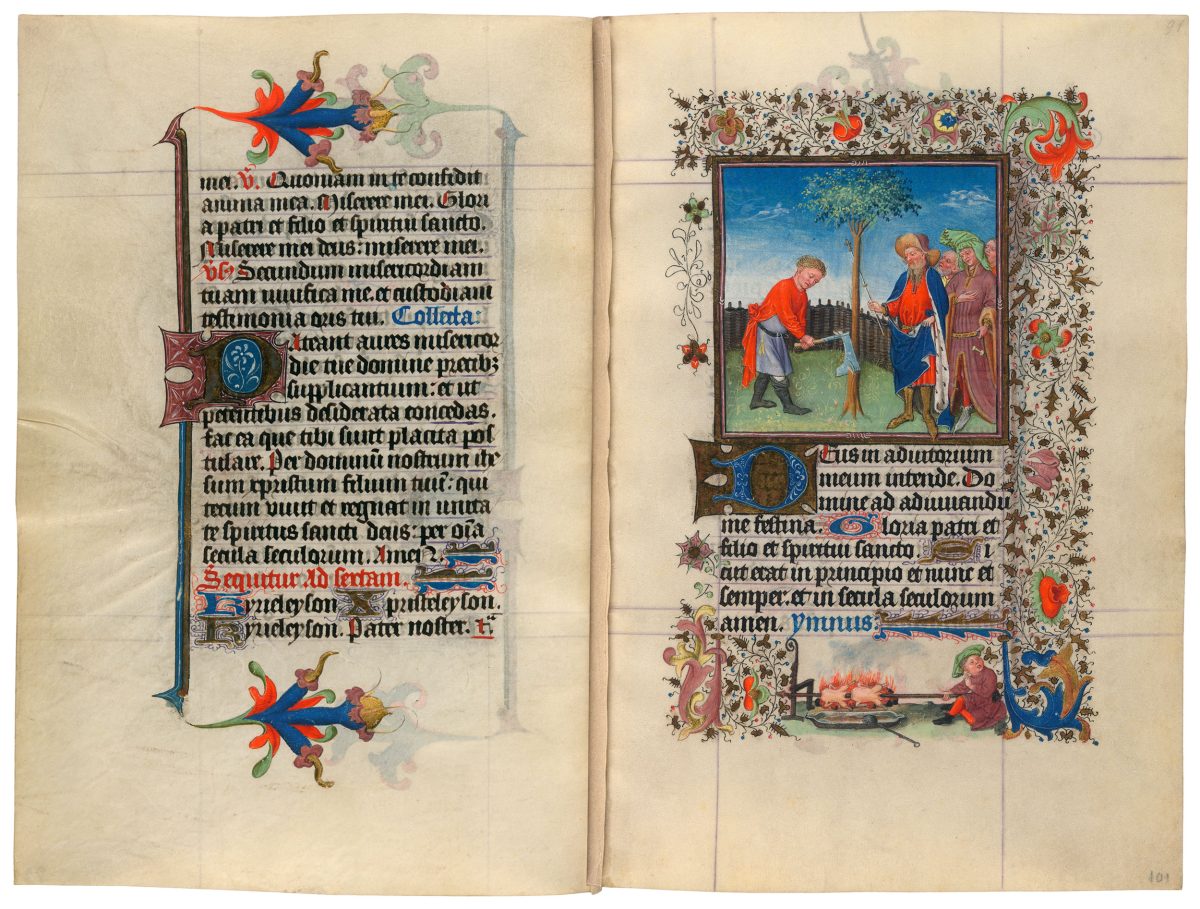
Solomon Ordering the Tree Cut Down

Tree Growing from Adam’s Grave
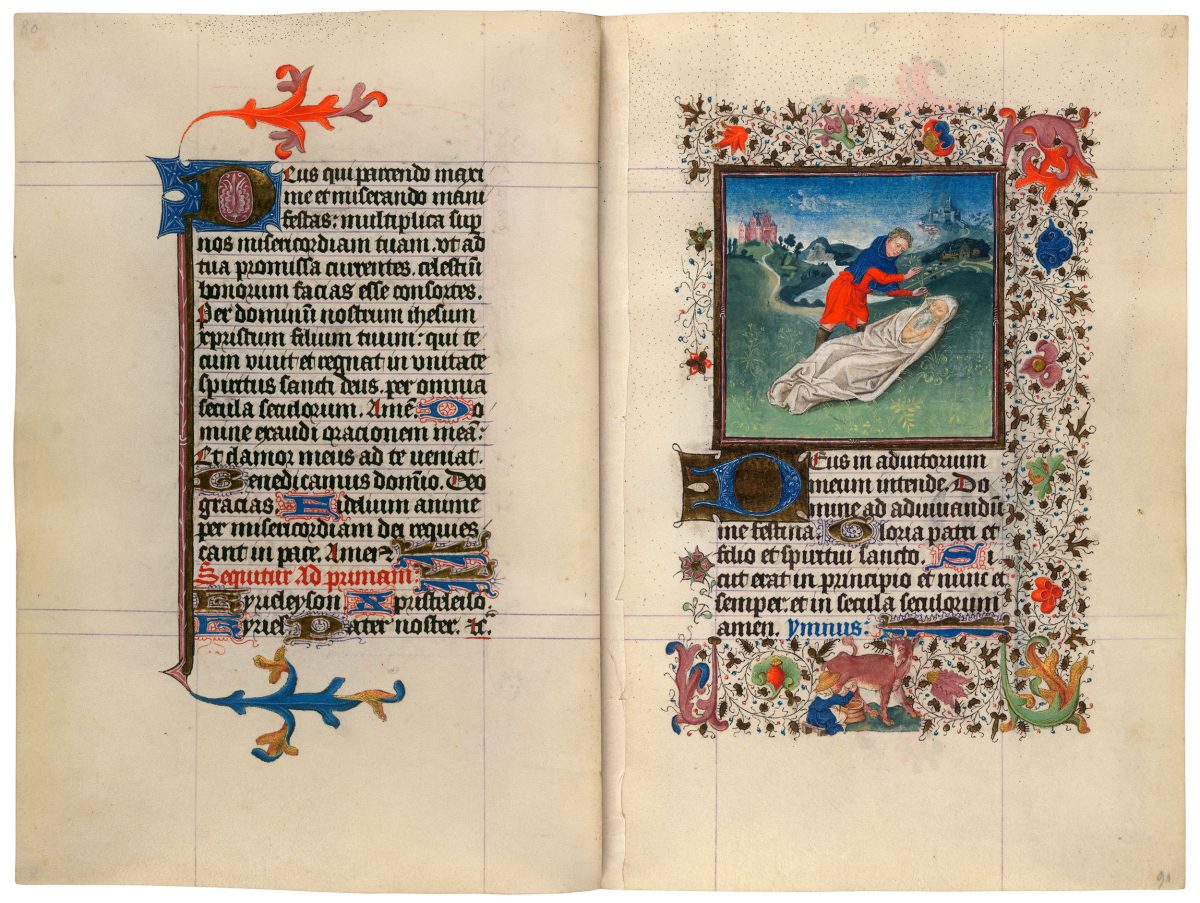
Seth Planting the Branch in the Mouth of the Dead Adam
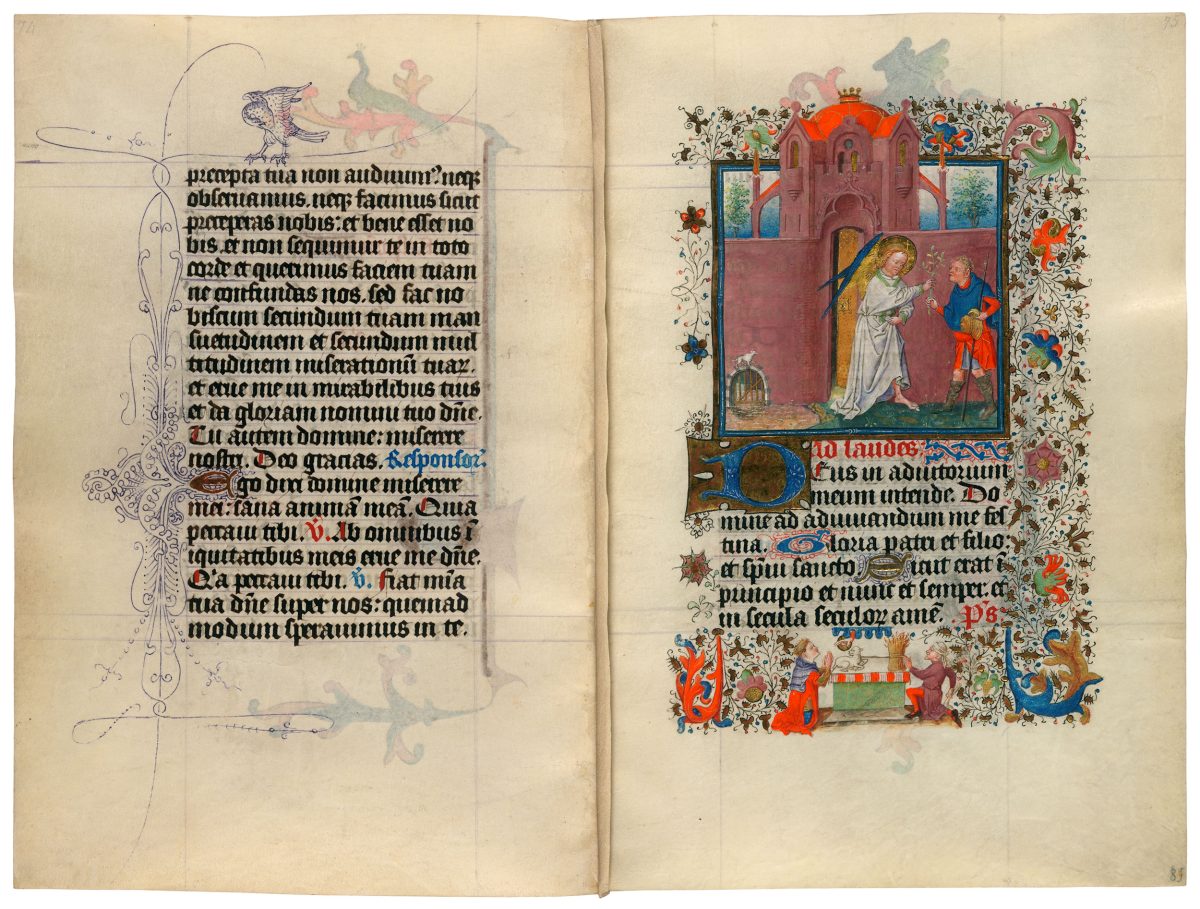
Archangel Michael Giving Seth a Branch from the Tree of Mercy
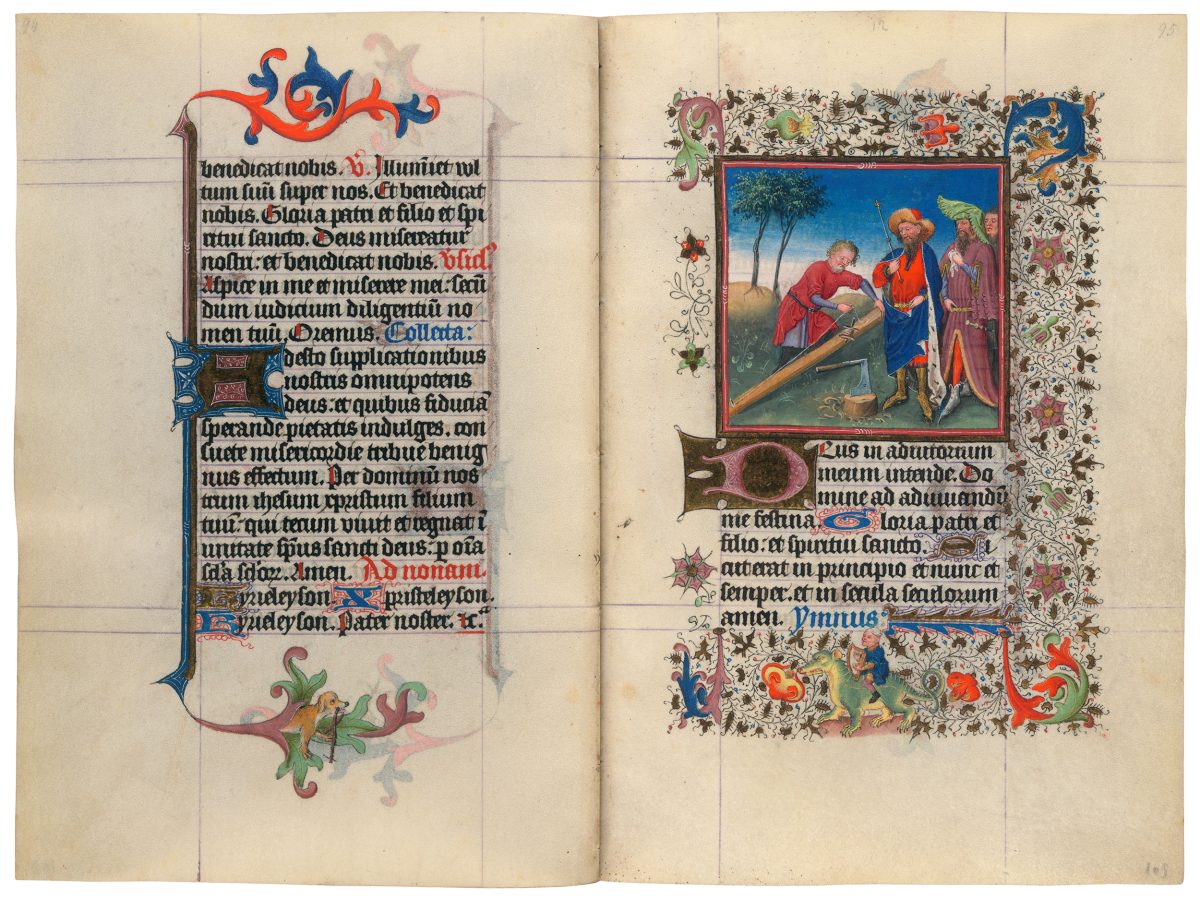
Solomon Observing the Measuring of the Timber

Tree of Jesse
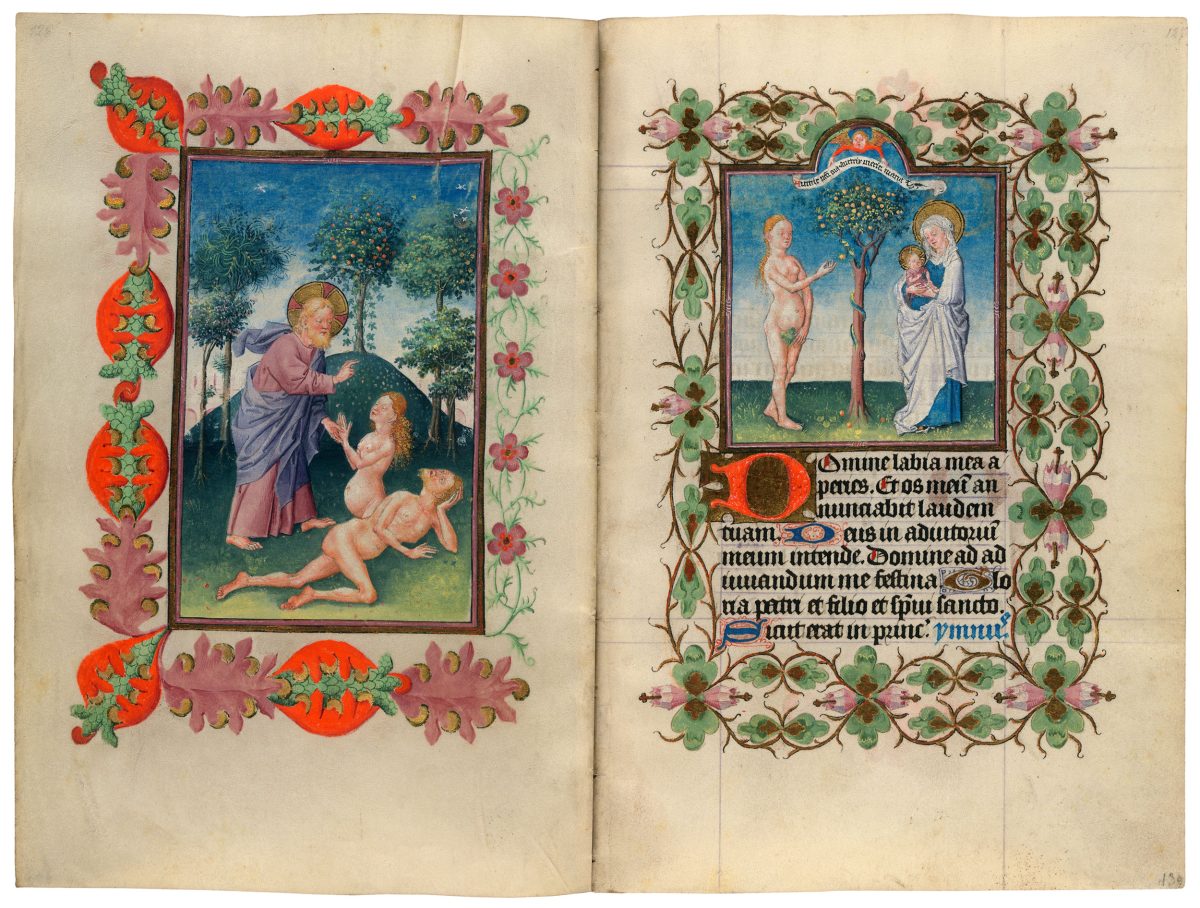
Creation of Eve Eve and the Virgin
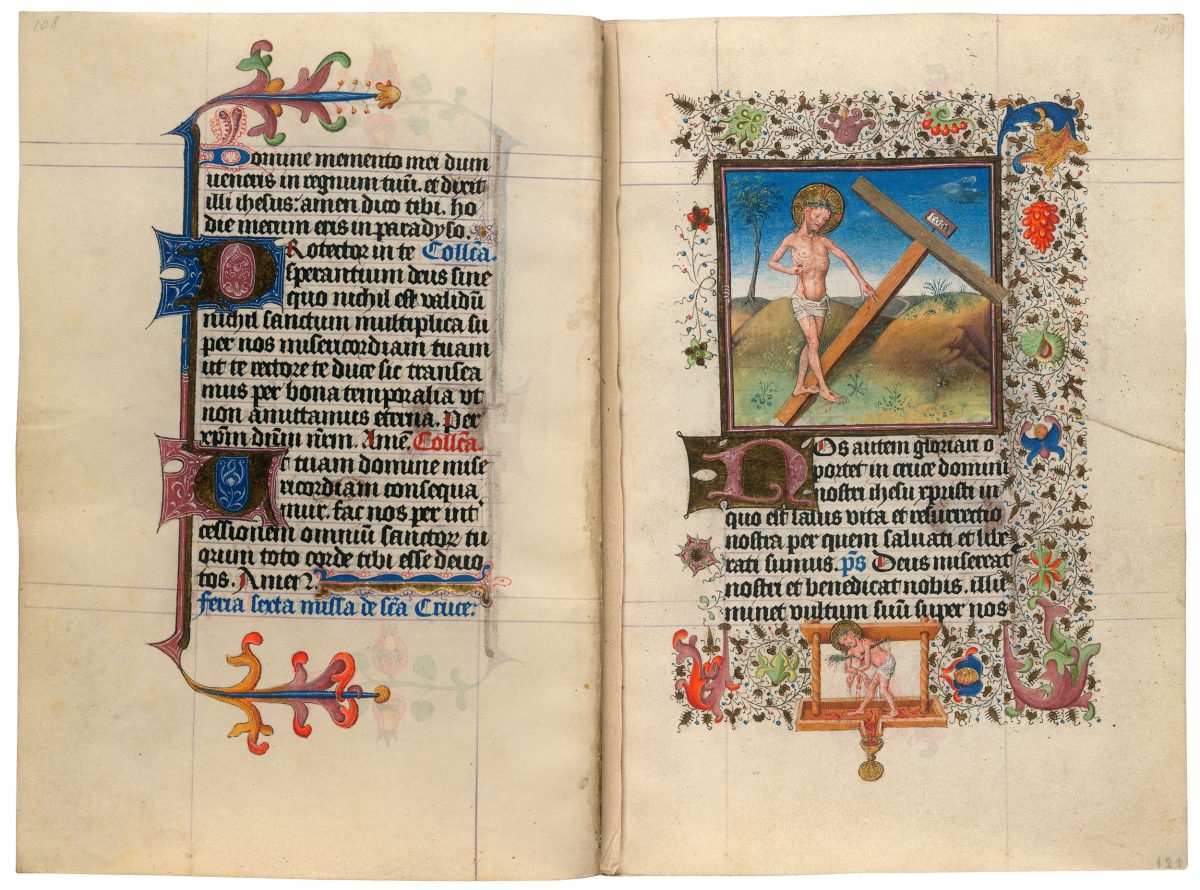
Man of Sorrows and the Cross
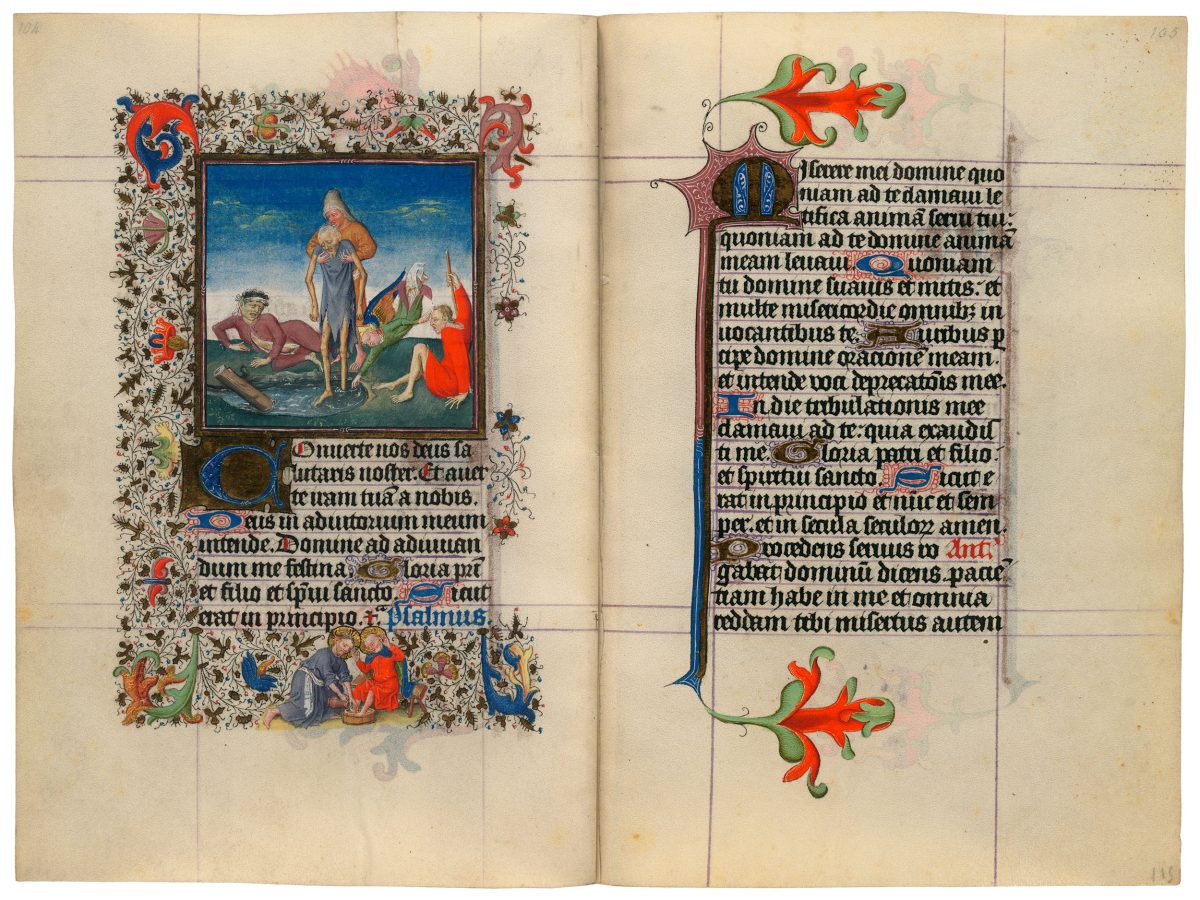
An Angel Stirs the Pool of Bethesda
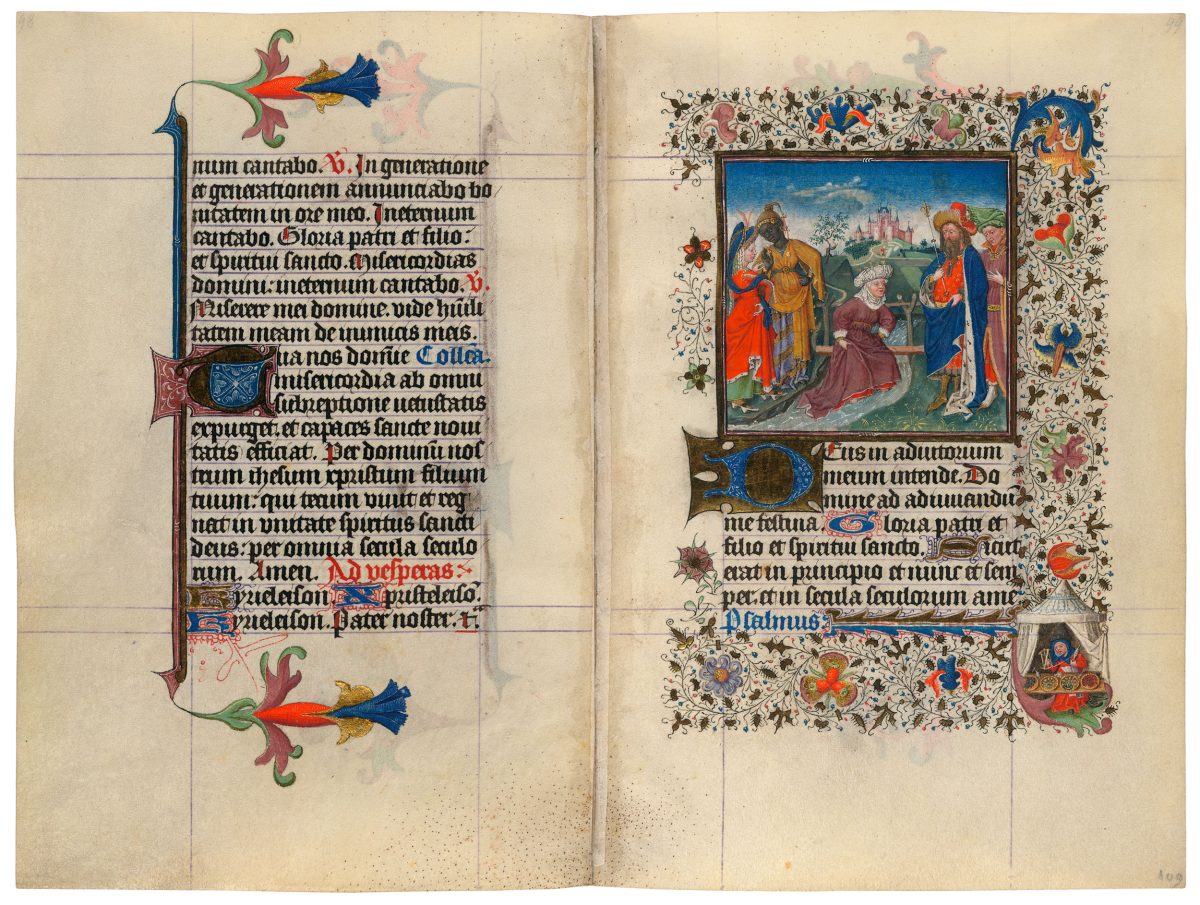
The Queen of Sheba Fording the Stream of Cedron
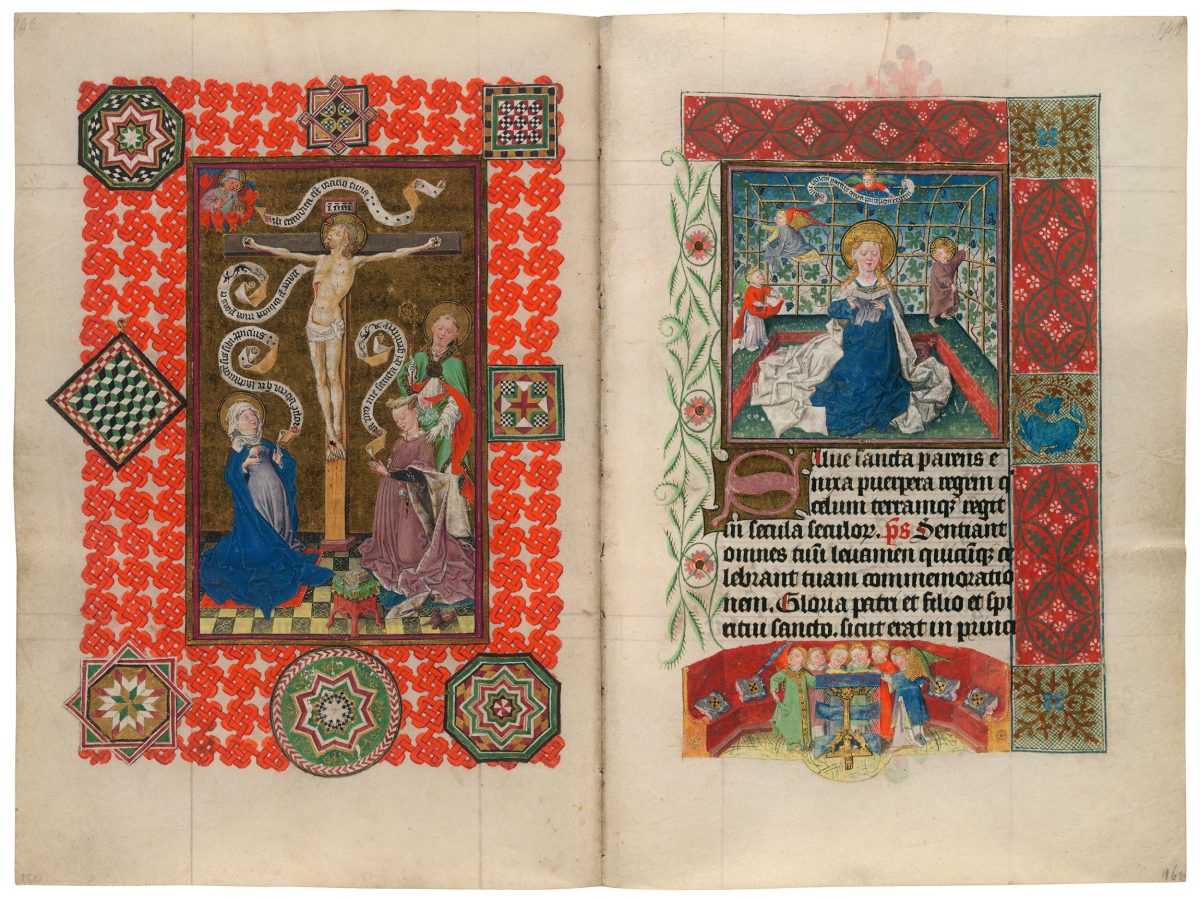
The Virgin and the Crucified Christ Intercede for Catherine of Cleves Virgin and Child in a Grape Arbor
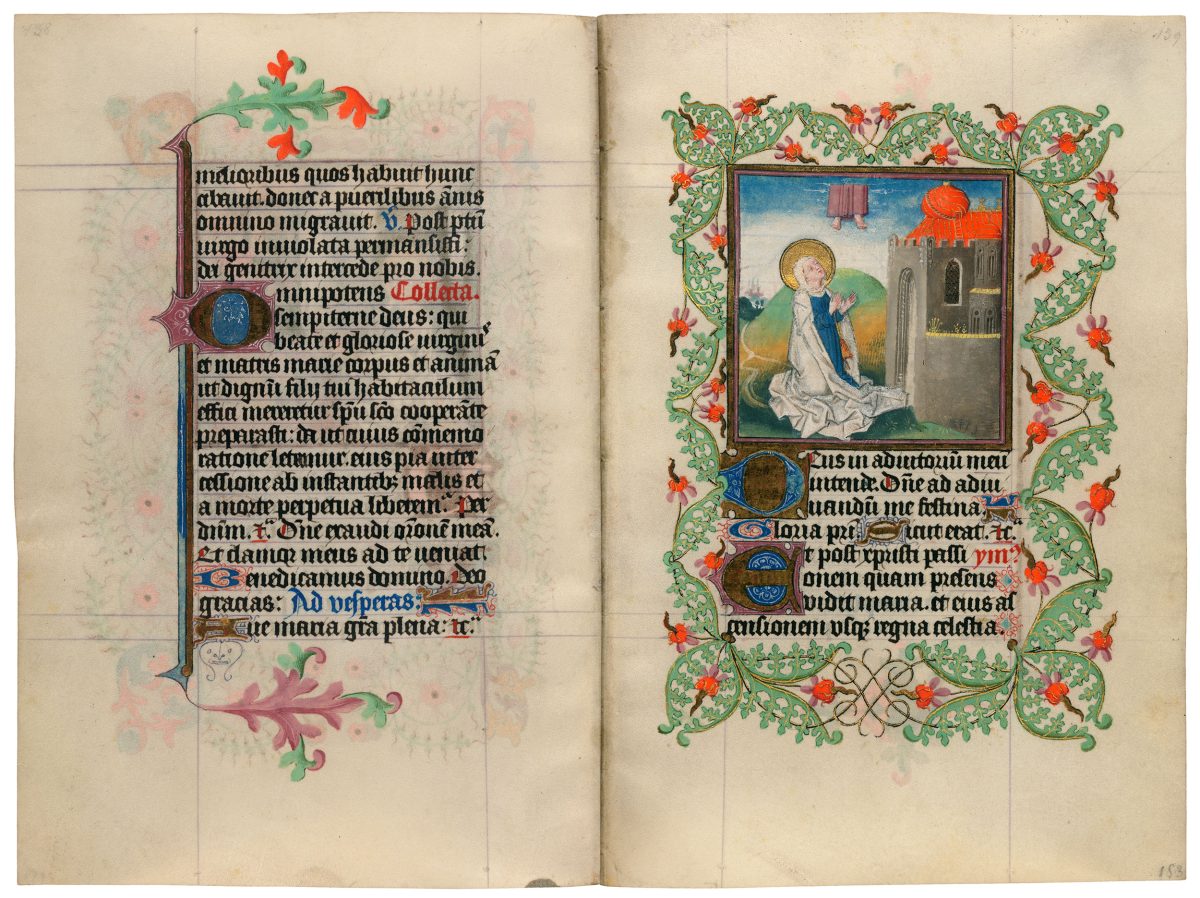
The Virgin Witnessing Christ’s Ascension

Holy Family at Supper
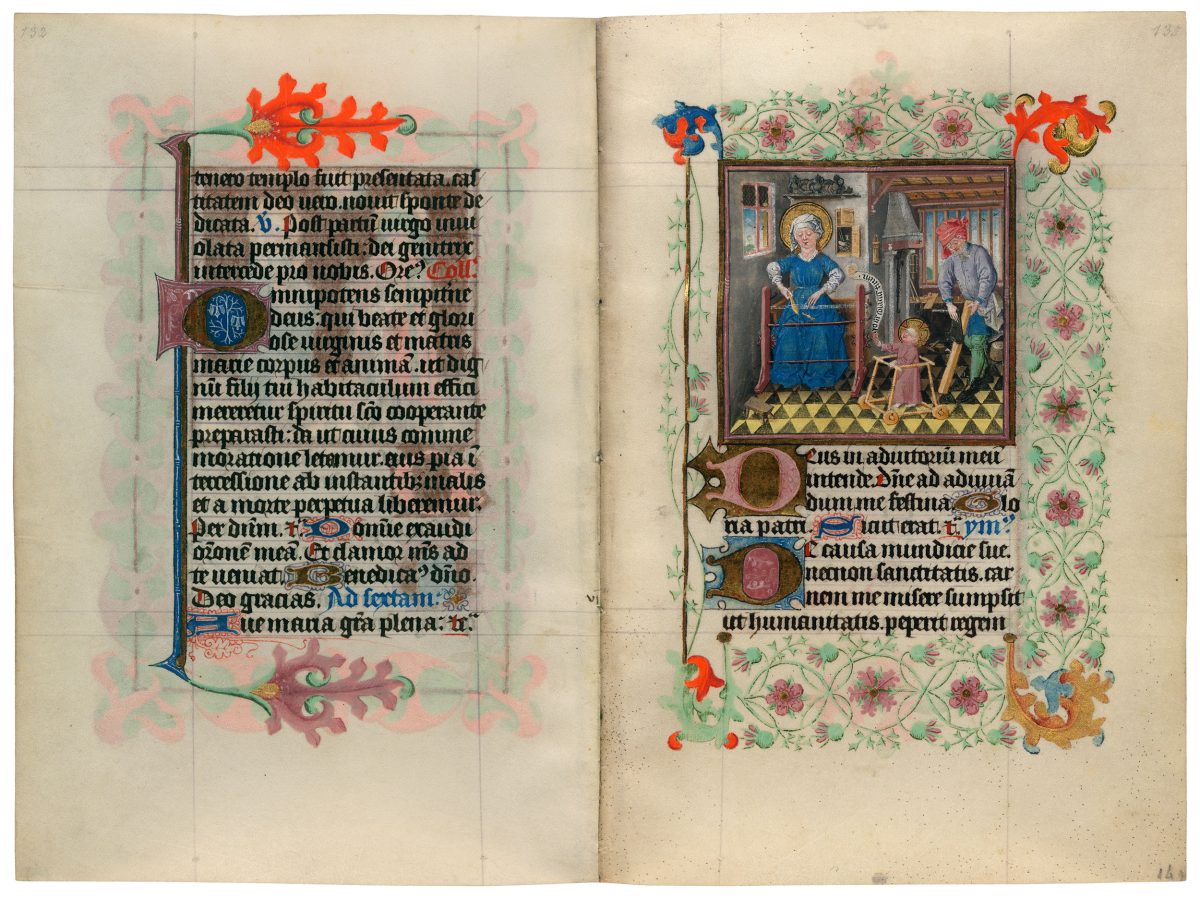
Holy Family at Work. Buy the card

Joachim and Anne
Penitential Psalms and Litany
Were the Seven Penitential Psalms written by King David? If it was him, he laid out his sins, seeking atonement for adultery with Bathsheba and the murder of her husband, Uriah. In another commission of sin, David offended God by ordering a census of Israel and Judah. These seven psalms are nowadays linked to the Seven Deadly Sins.
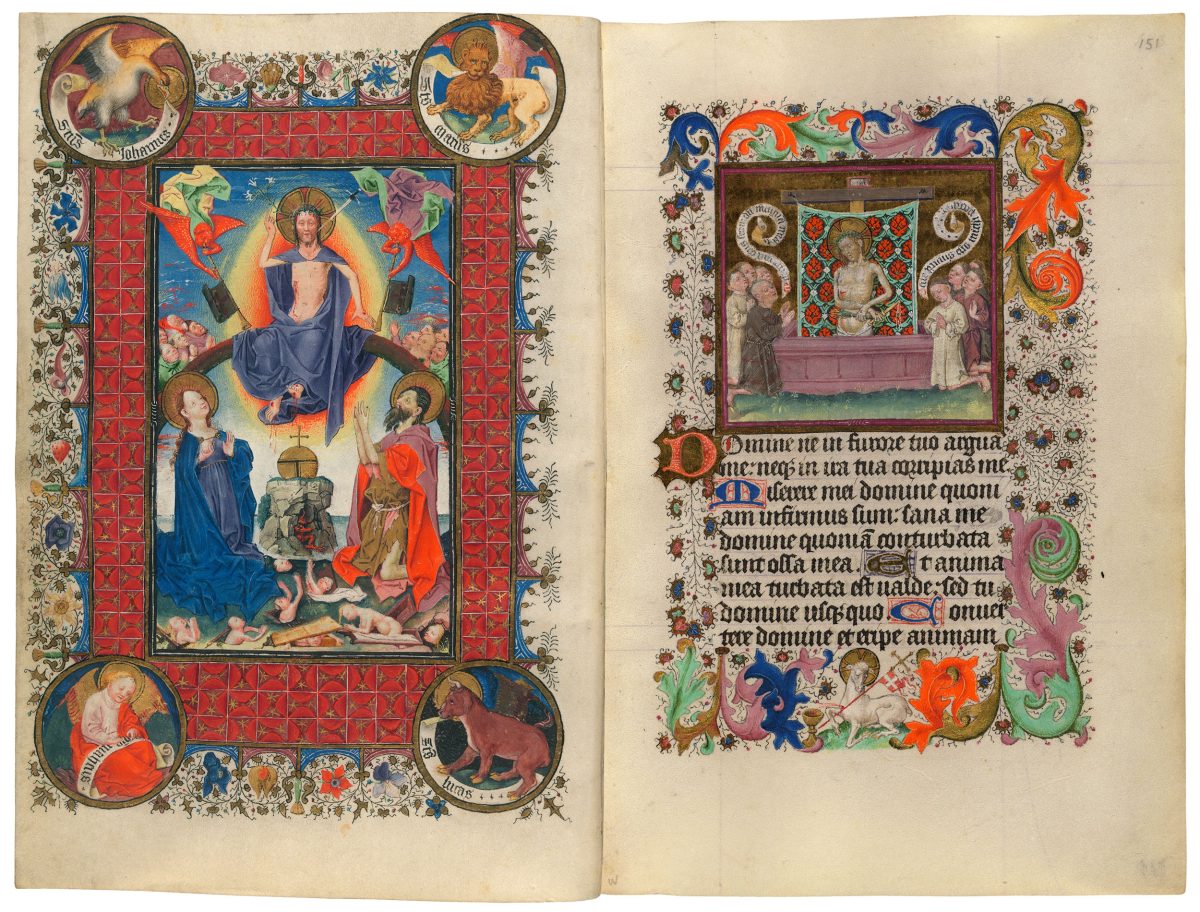
Office of the Dead
The Office of the Dead gives the pathway to heaven, taking in a detour (lasting, potentially, thousands of years) in purgatory, where fire cleansed the soul of unforgiven sin. Praying the Office of the Dead for one’s deceased friends or relatives meant believers would be fast-tracked to paradise. Recited at funerals, the Office of the Dead was also ideally prayed every day.
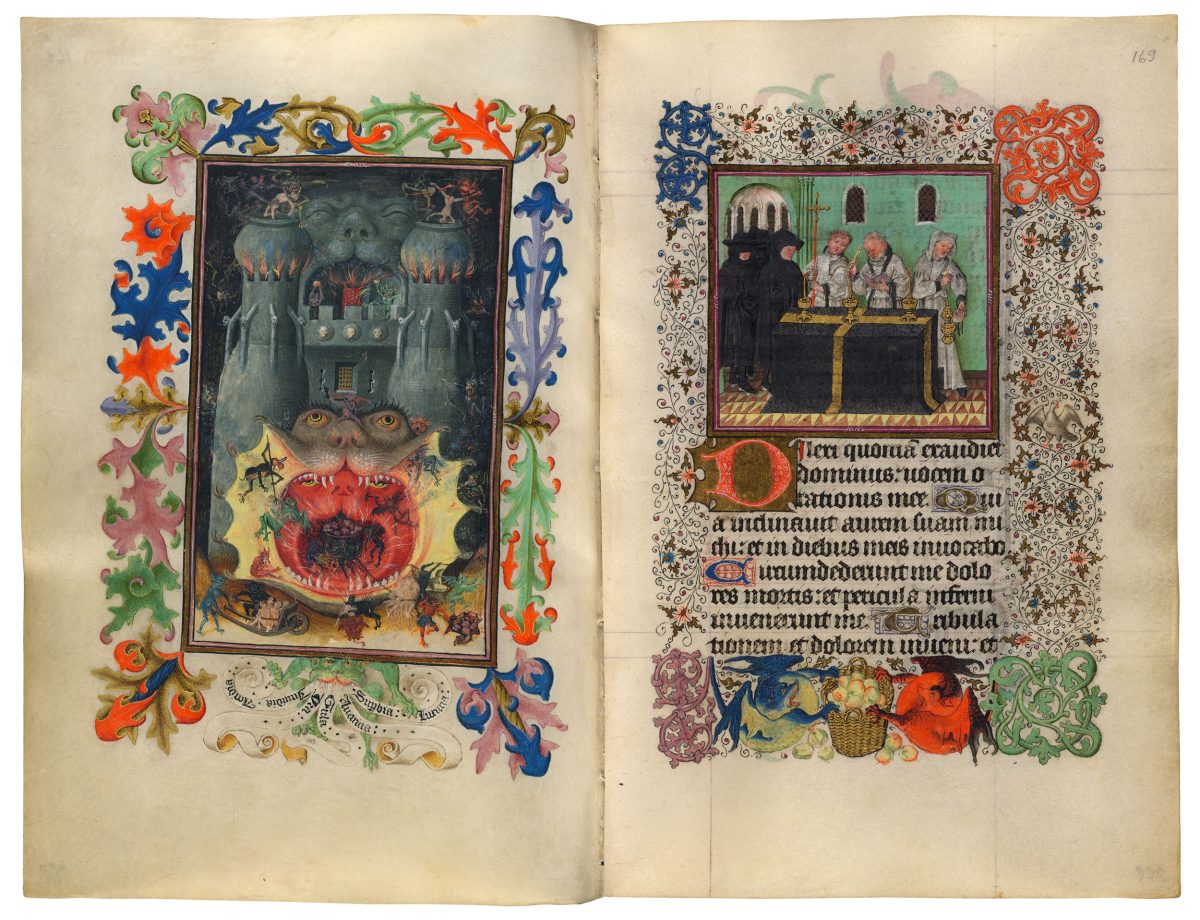
Suffrages
Suffrages are short prayers to individual saints asking them for release from pain, debt and whatever the saint was patron of.
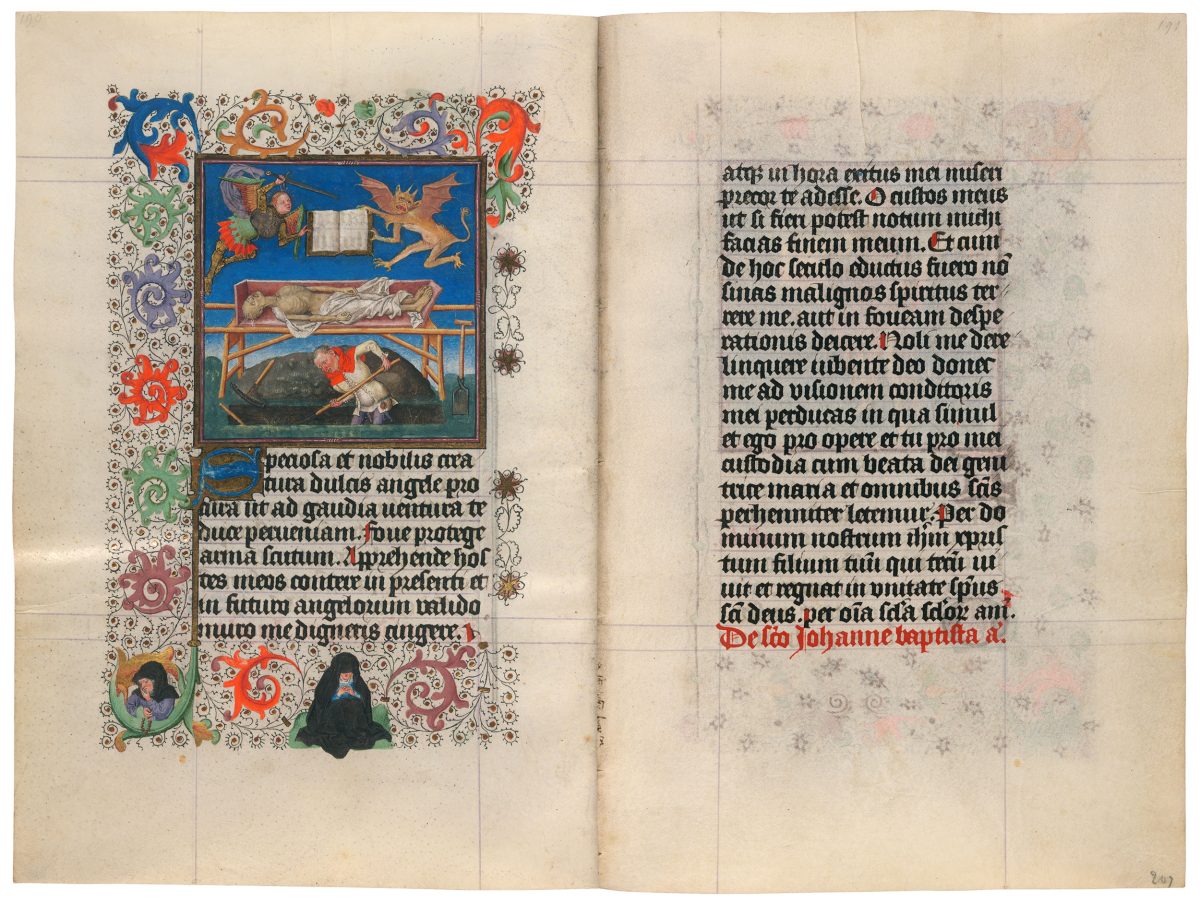
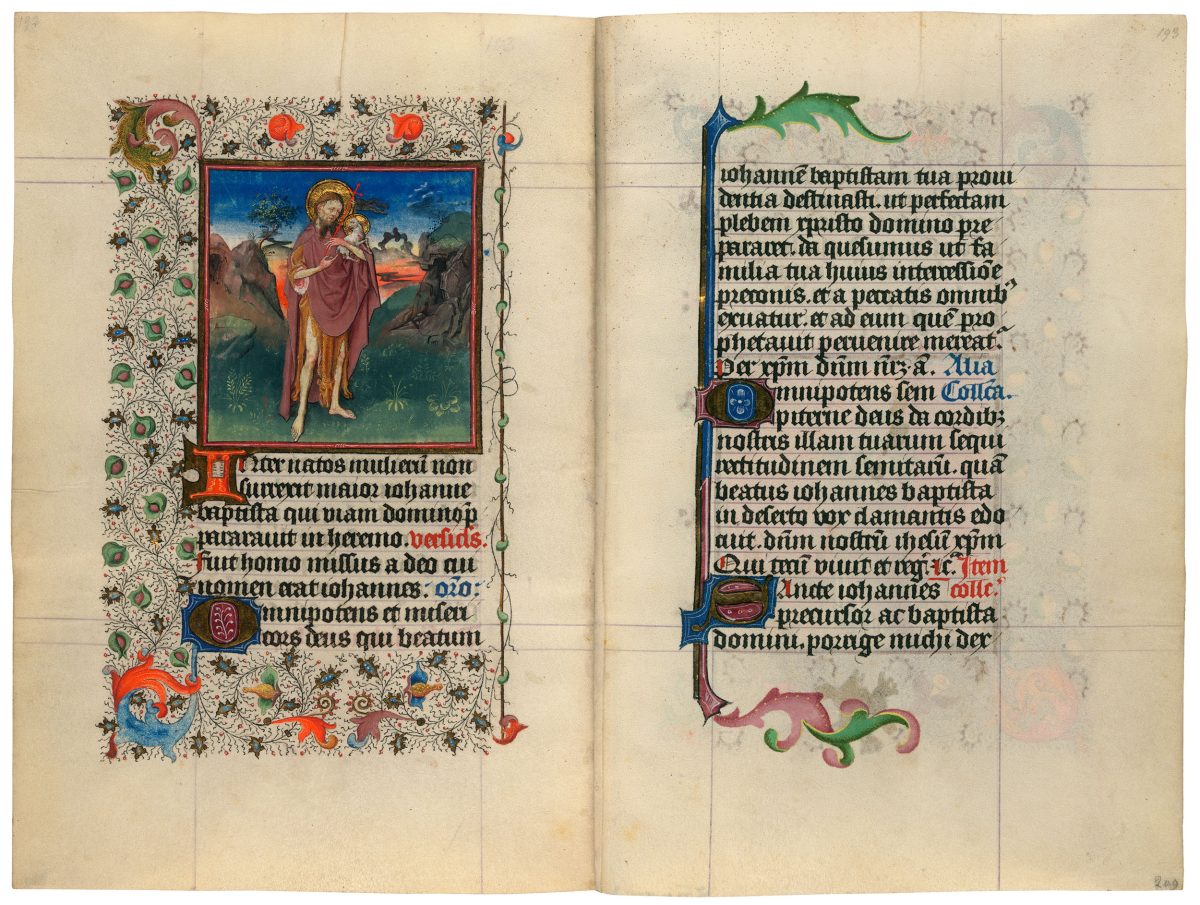
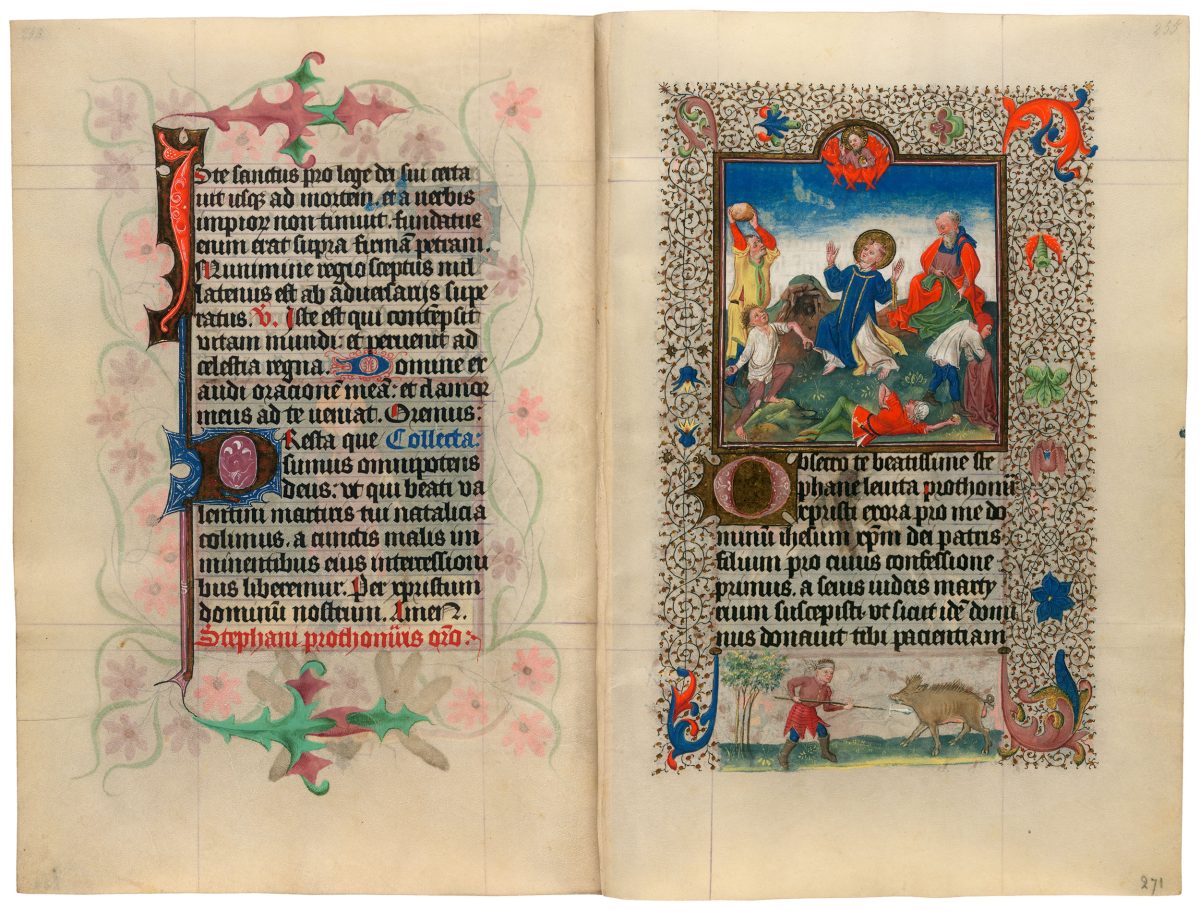
Lapidation of St. Stephen
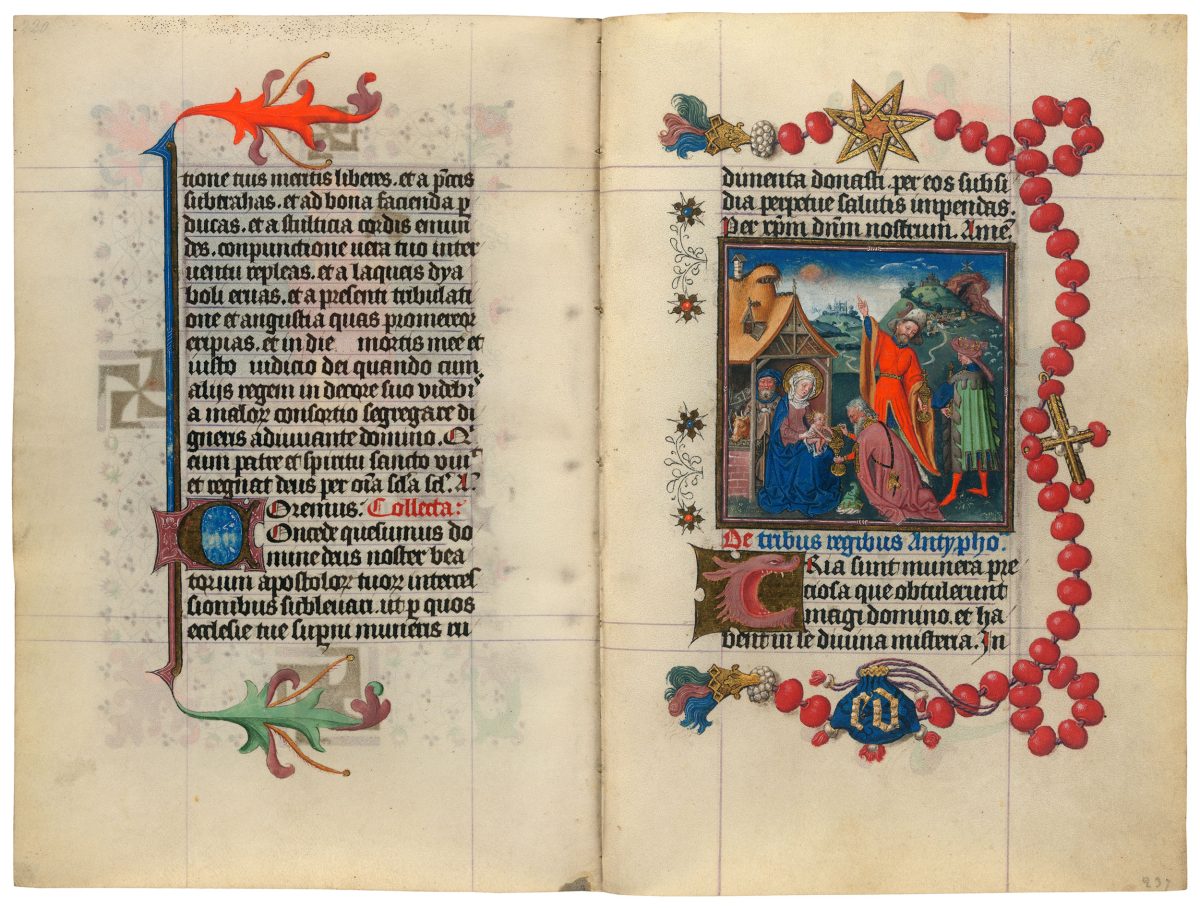
Adoration of the Magi
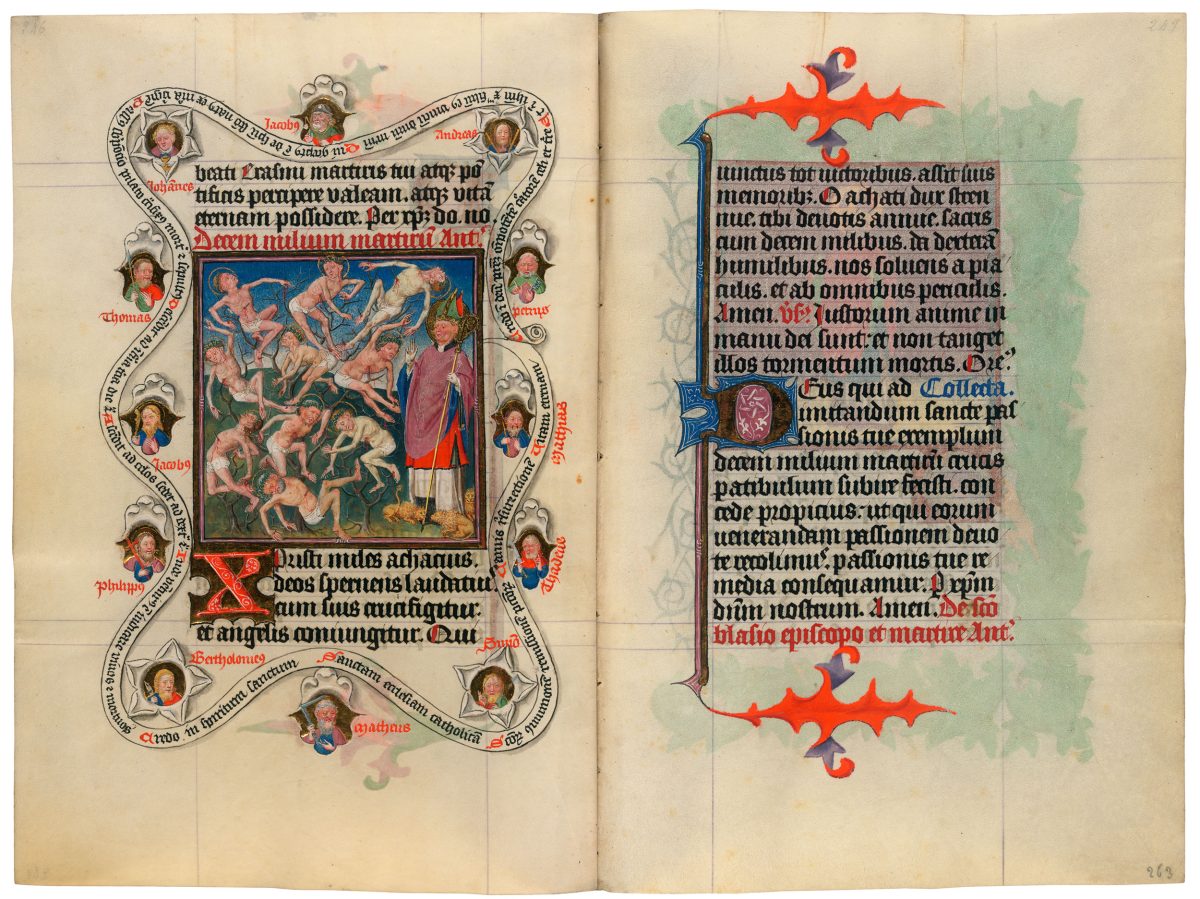
Ten Thousand Martyrs and St. Acacius
Buy Catherine of Cleves greeting cards in the shop.
Would you like to support Flashbak?
Please consider making a donation to our site. We don't want to rely on ads to bring you the best of visual culture. You can also support us by signing up to our Mailing List. And you can also follow us on Facebook, Instagram and Twitter. For great art and culture delivered to your door, visit our shop.


